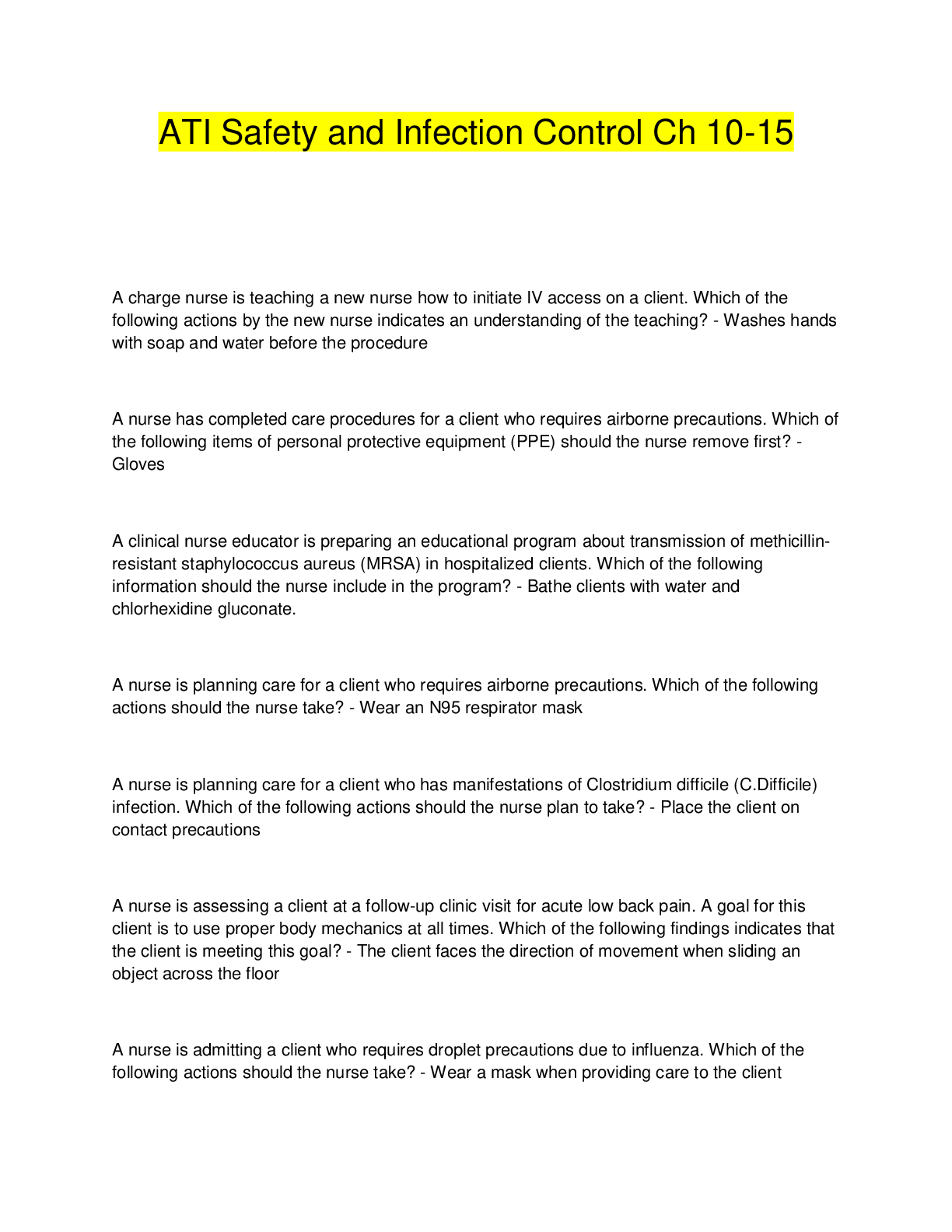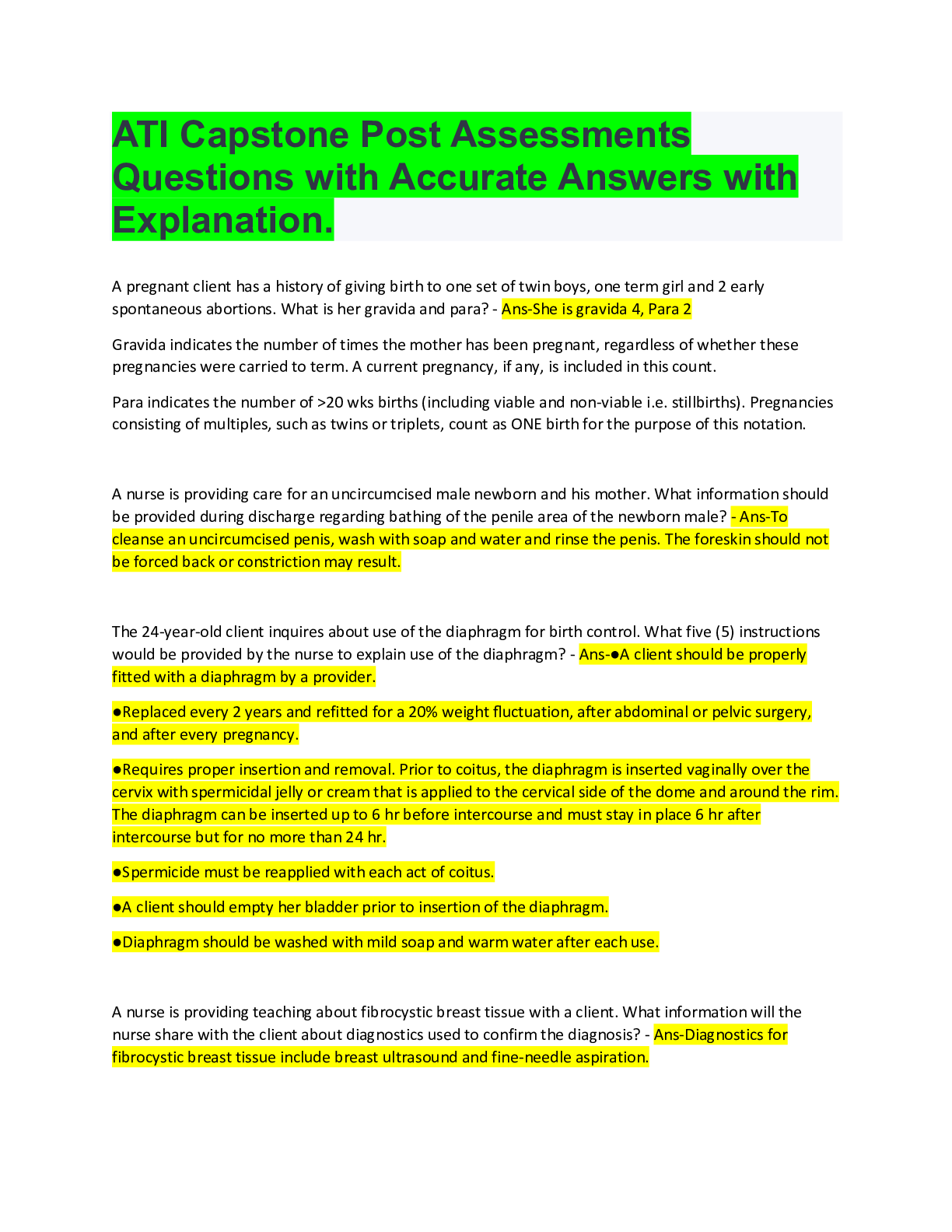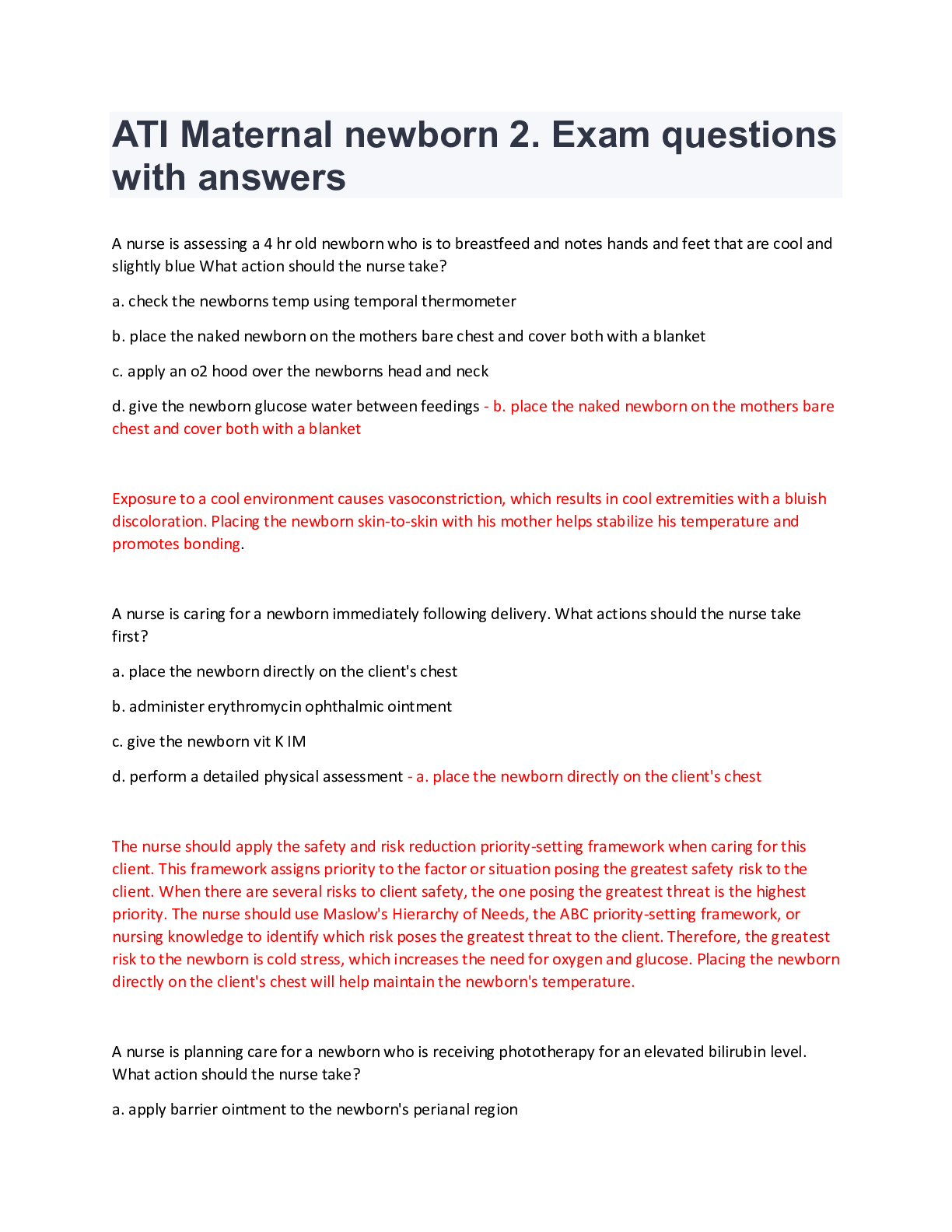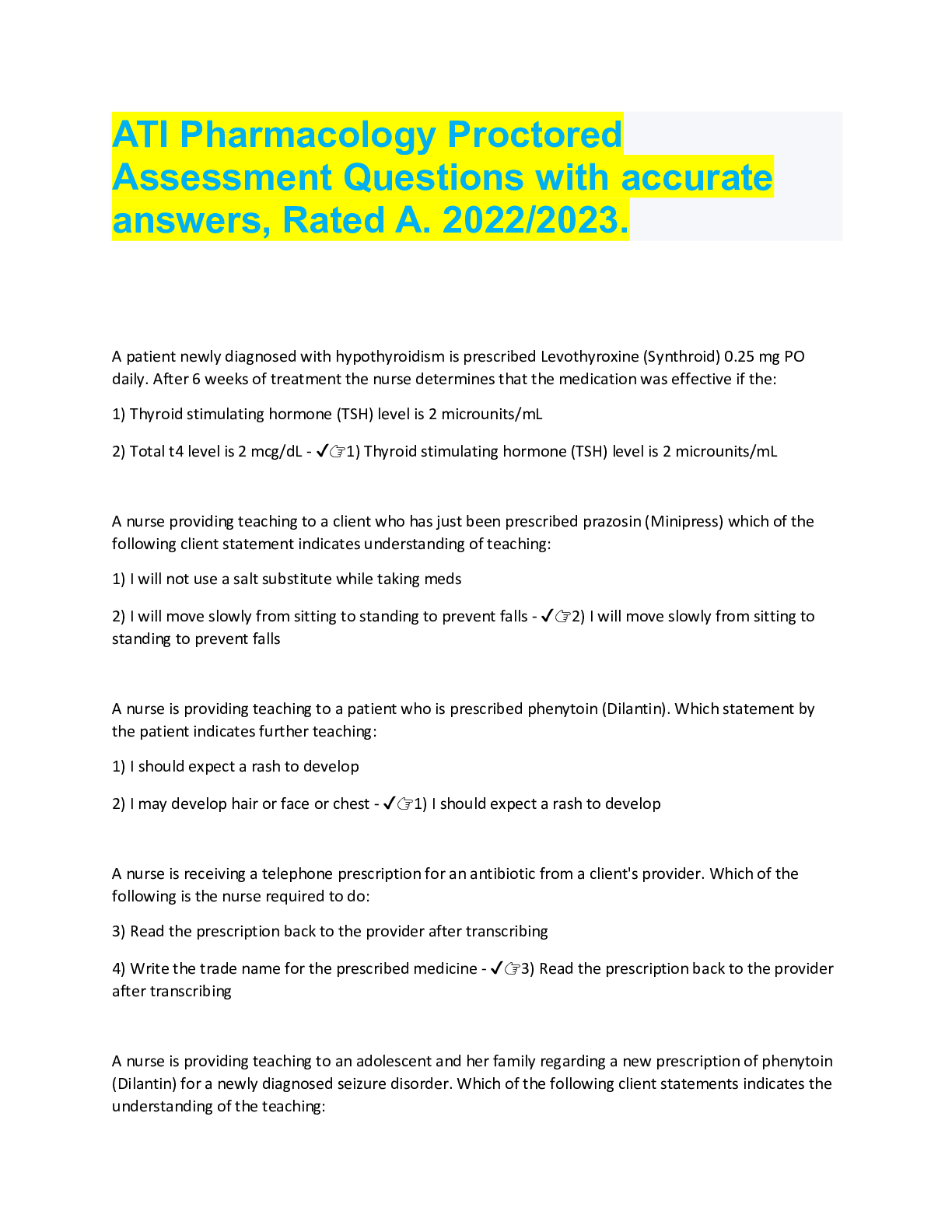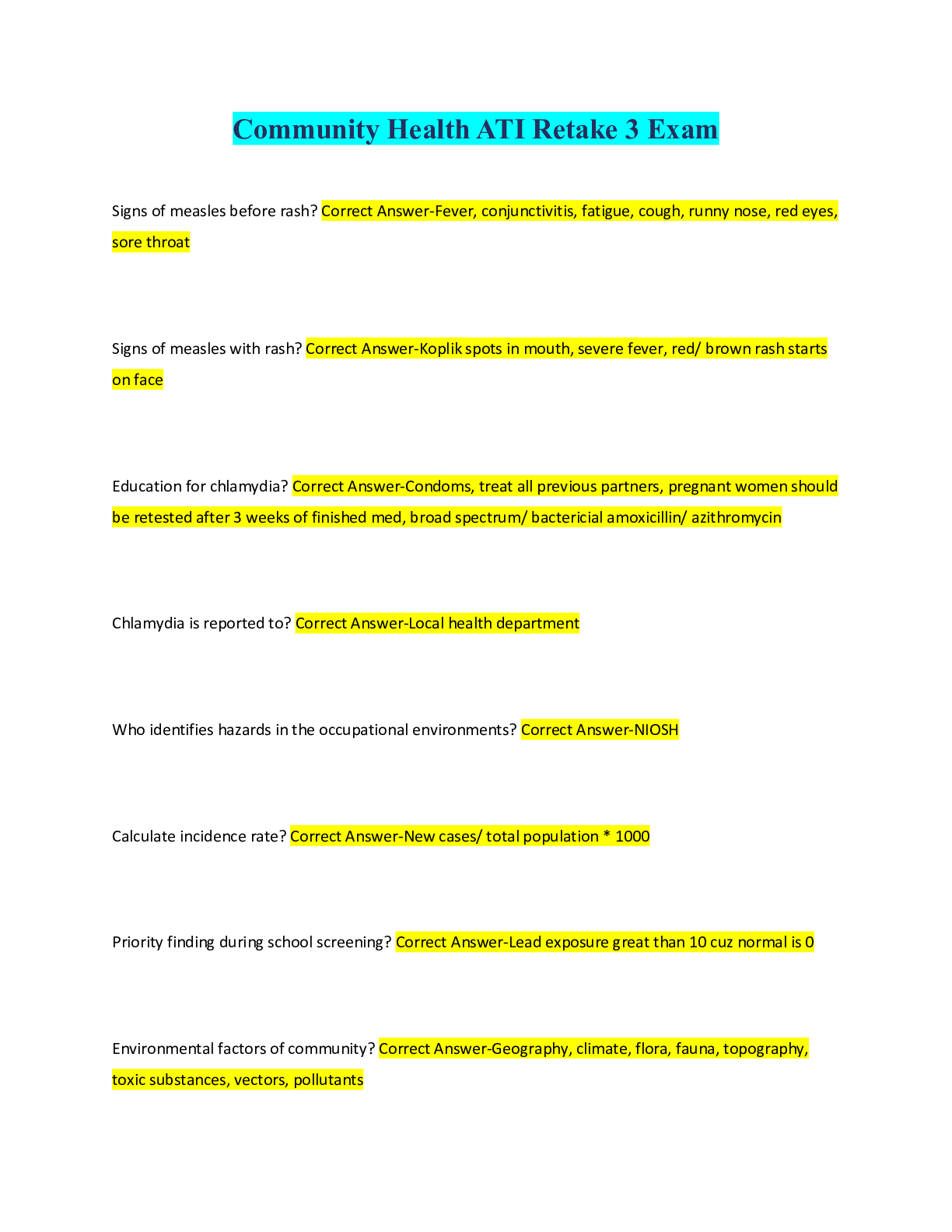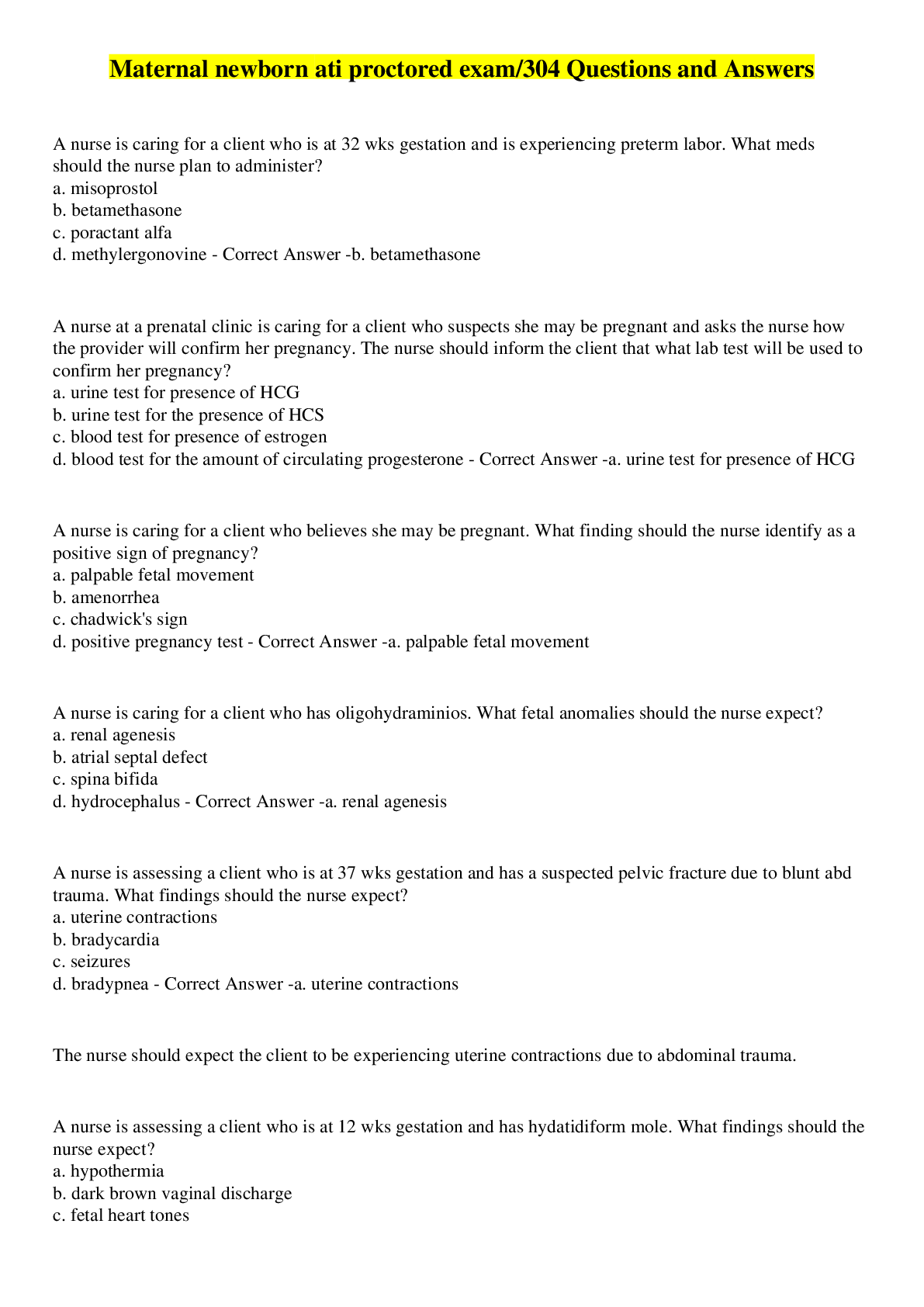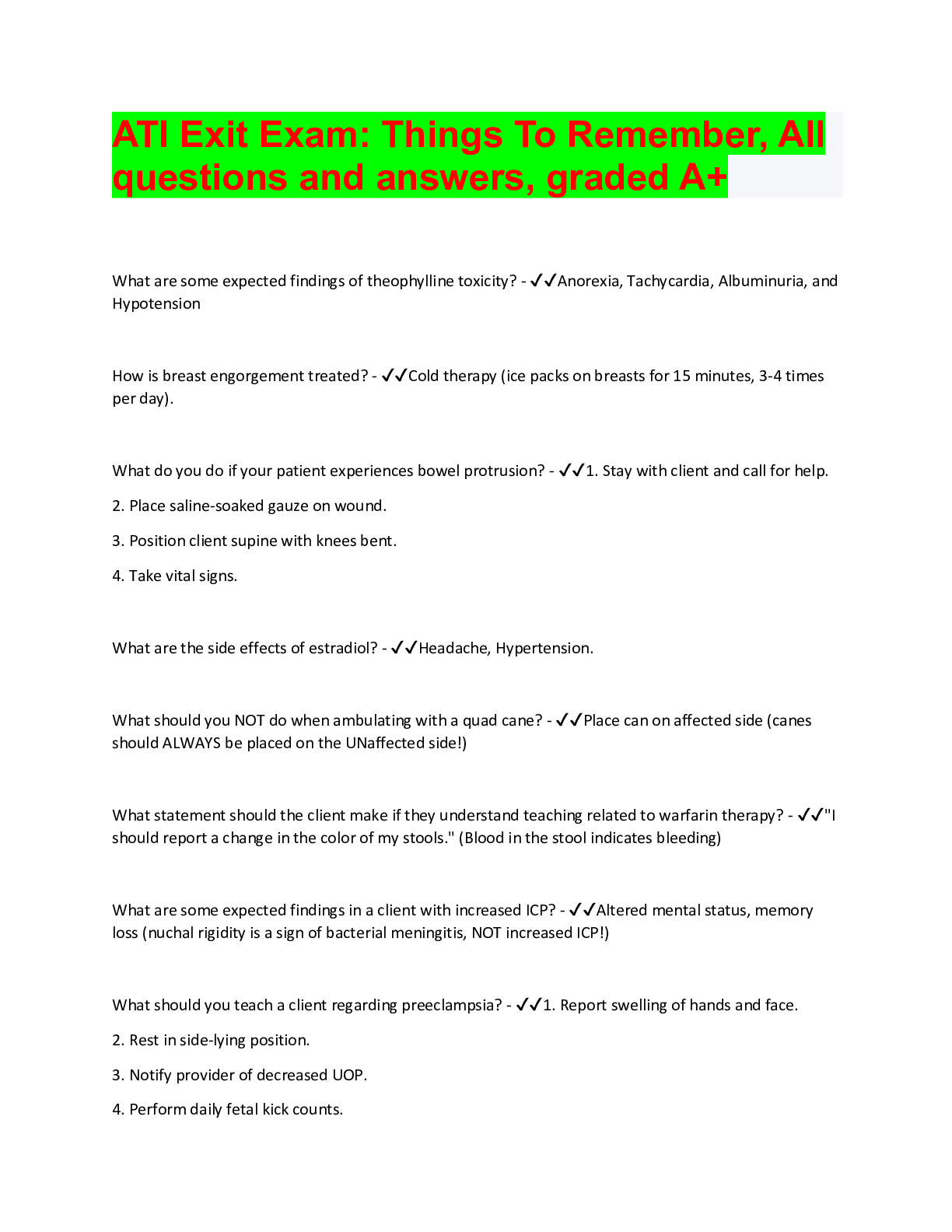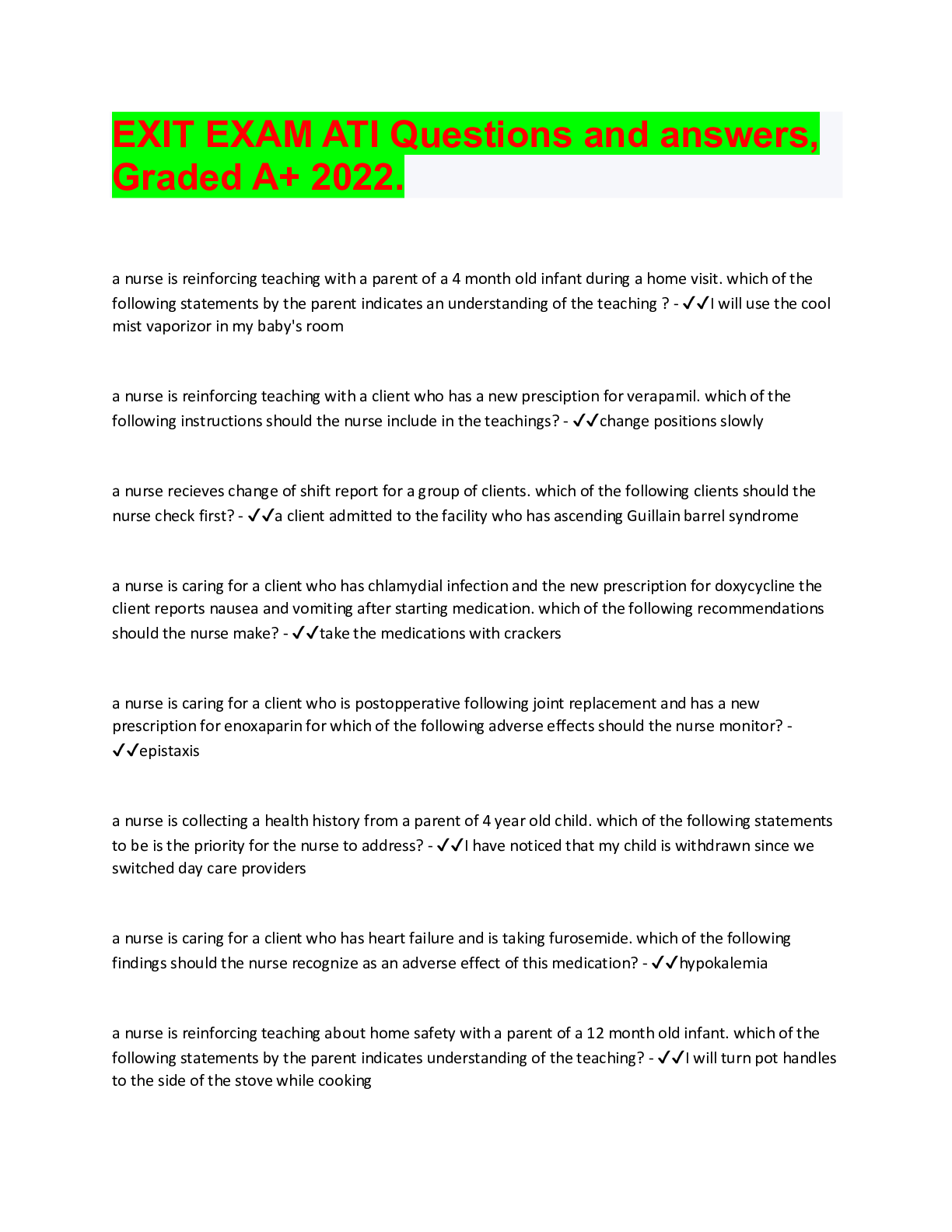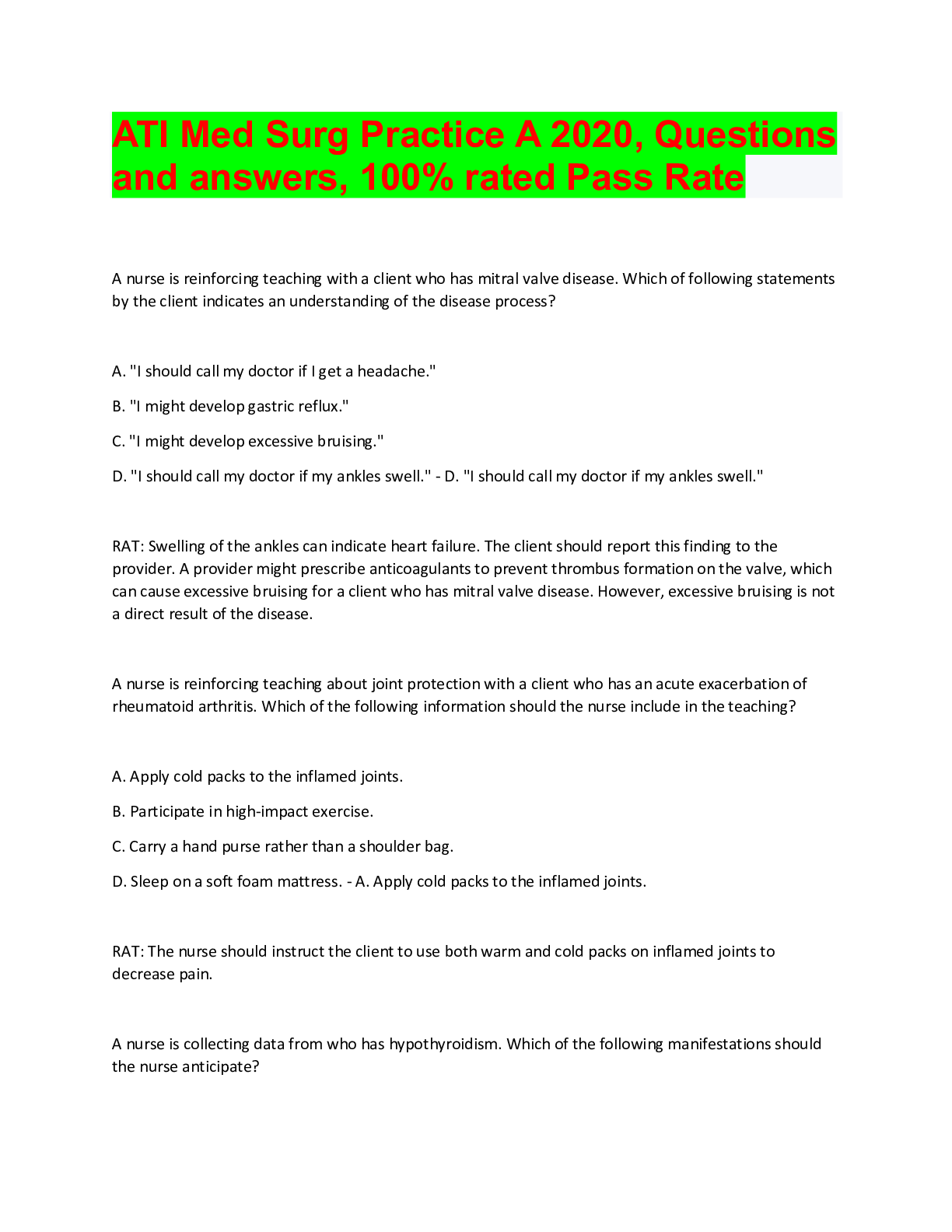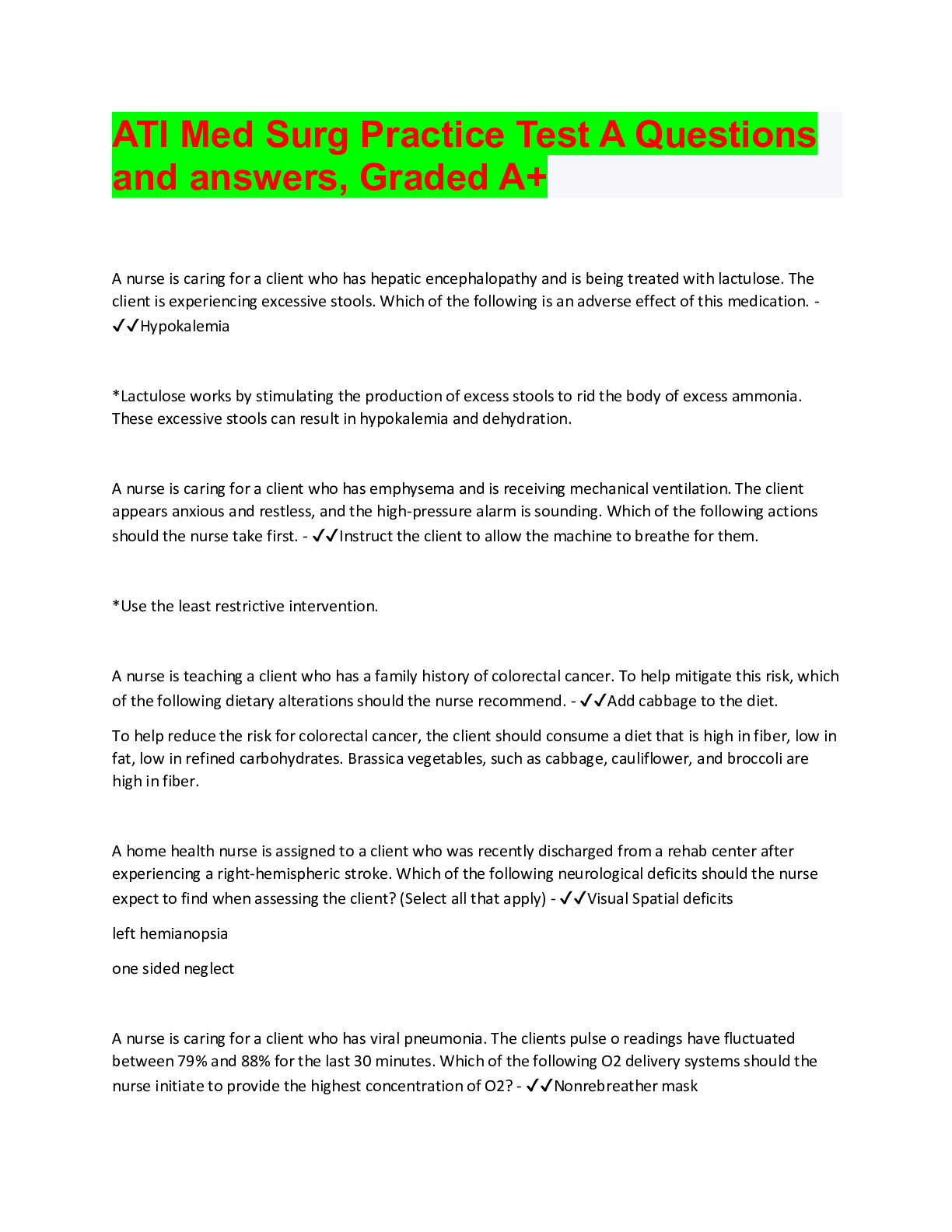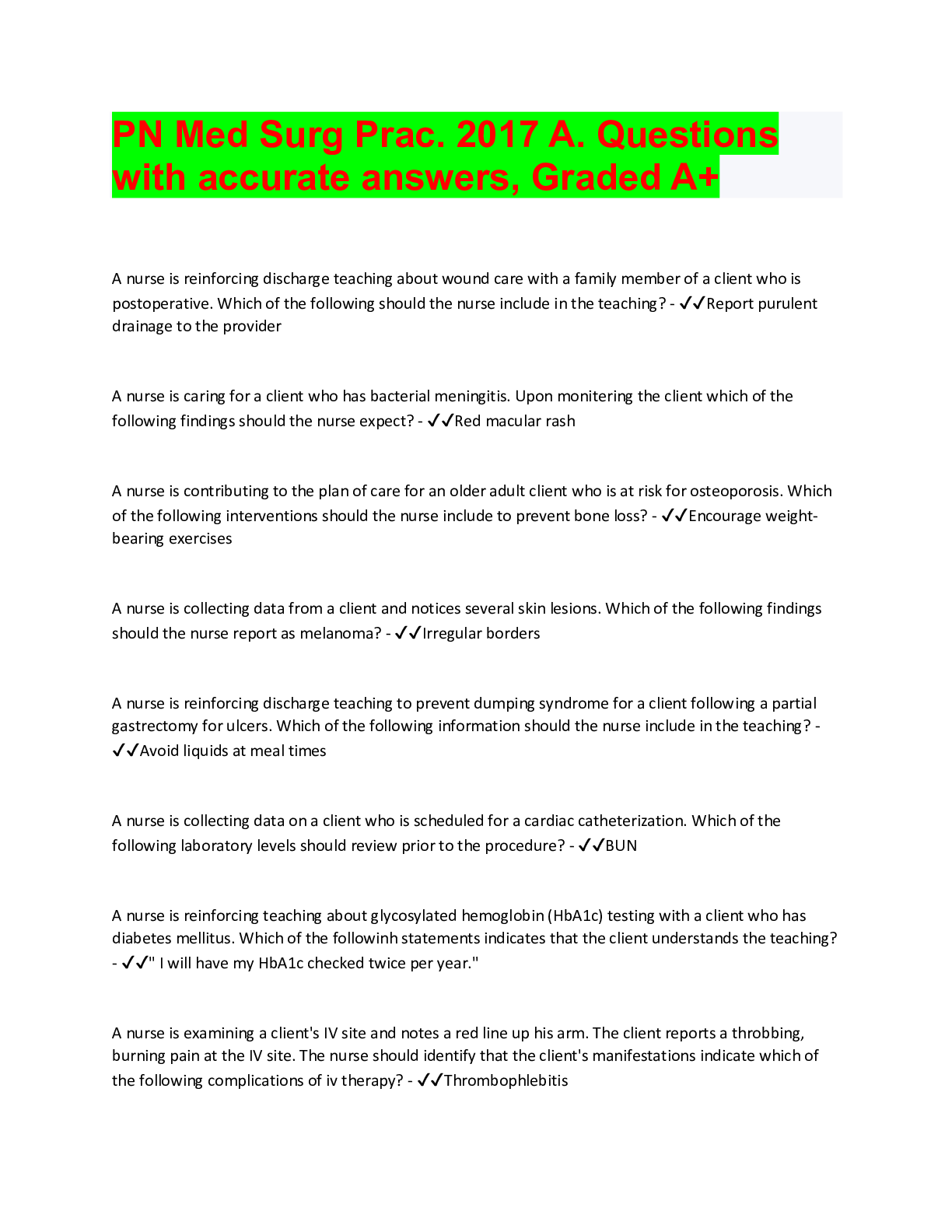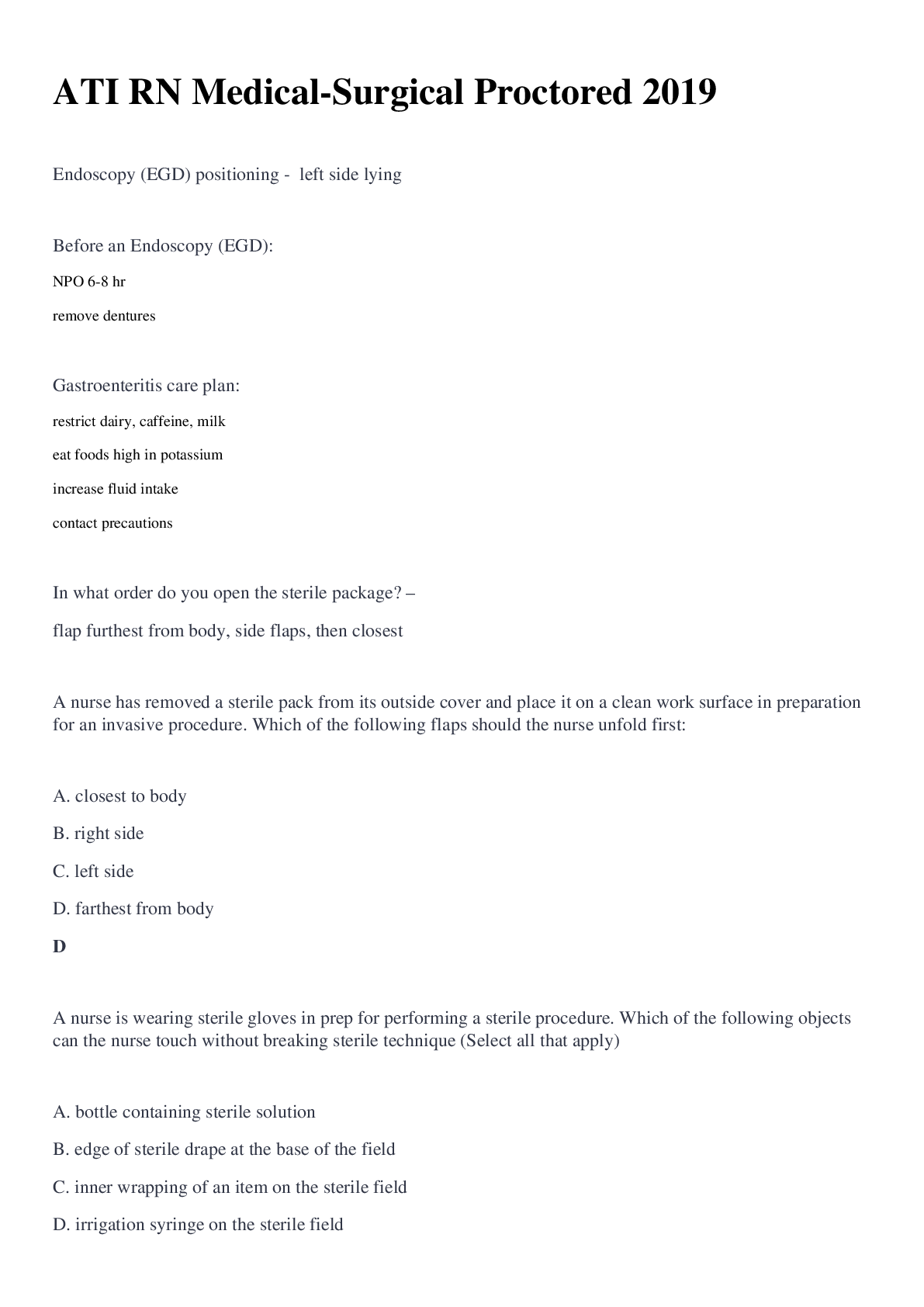*NURSING > ATI > ATI Med Surg Practice A 2020 with rationales. Questions with accurate answers, Graded A+ (All)
ATI Med Surg Practice A 2020 with rationales. Questions with accurate answers, Graded A+
Document Content and Description Below
ATI Med Surg Practice A 2020 with rationales. Questions with accurate answers, Graded A+ A nurse is reinforcing teaching with a client who has mitral valve disease. Which of following statements ... by the client indicates an understanding of the disease process? A. "I should call my doctor if I get a headache." B. "I might develop gastric reflux." C. "I might develop excessive bruising." D. "I should call my doctor if my ankles swell." - ✔✔D. "I should call my doctor if my ankles swell." RAT: Swelling of the ankles can indicate heart failure. The client should report this finding to the provider. -A provider might prescribe anticoagulants to prevent thrombus formation on the valve, which can cause excessive bruising for a client who has mitral valve disease. However, excessive bruising is not a direct result of the disease. A nurse is reinforcing teaching about joint protection with a client who has an acute exacerbation of rheumatoid arthritis. Which of the following information should the nurse include in the teaching? A. Apply cold packs to the inflamed joints. B. Participate in high-impact exercise. C. Carry a hand purse rather than a shoulder bag. D. Sleep on a soft foam mattress. - ✔✔A. Apply cold packs to the inflamed joints. RAT: The nurse should instruct the client to use both warm and cold packs on inflamed joints to decrease pain. A nurse is collecting data from who has hypothyroidism. Which of the following manifestations should the nurse anticipate? A. Blurred vision B. Insomnia C. Bradycardia D. Weight loss - ✔✔C. Bradycardia -The nurse should identify that blurred vision is a manifestation of hyperthyroidism -The nurse should identify that insomnia is a manifestation of hyperthyroidism that is caused by an increase in the client's metabolic rate. -The nurse should identify that weight loss is a manifestation of hyperthyroidism caused by an increase in the client's metabolic rate. RAT: The nurse should identify that bradycardia is a manifestation of hypothyroidism that is caused by a decrease in the client's metabolic rate. A nurse is reinforcing teaching with an adolescent child regarding testicular self-examination. Which of the following statements by the client indicates an understanding of the teaching? A. "I will perform the exam before I shower." B. "I will check my testicles every 6 months." C. "I understand that testicular cancer is typically painless." D. "I understand that pea-sized lumps are normal." - ✔✔C. "I understand that testicular cancer is typically painless." RAT: Clients should report a lump that is not painful because testicular cancer is typically painless. Clients should perform a testicular self-examination after a warm shower. Clients should perform a testicular self-examination monthly. A nurse is contributing to the plan of care of a client who is at risk for osteoporosis. Which of the following interventions should the nurse include to prevent bone loss? A. Increase fluid intake. B. Encourage range-of-motion exercises. C. Massage bony prominences. D. Encourage weight-bearing exercises. - ✔✔D. Encourage weight-bearing exercises. Weight-bearing exercises, such as walking, can maintain bone mass by reducing bone demineralization, thus helping to prevent osteoporosis. -Fluid intake is beneficial for general health and wellness, and it helps to treat some disorders. Caffeine and alcohol intake can increase the client's risk for developing osteoporosis. However, fluid intake does not prevent bone loss. -Range-of-motion exercises are beneficial for general health and wellness, and they help to maintain flexibility and prevent contractures. However, range-of-motion exercises do not prevent bone loss. -Massaging bony prominences should be avoided because it can traumatize deep tissues. A nurse is reinforcing teaching about management of constipation with a client who has hypothyroidism. Which of the following instructions should the nurse include in the teaching? A. Increase intake of fiber-rich foods. B. Take a laxative every morning. C. Maintain a fluid intake of 1,200 mL/day. D. Limit activity to preserve energy. - ✔✔A. Increase intake of fiber-rich foods. RAT: The nurse should instruct the client to increase the amount of fiber-rich foods in their diet. Dried beans and brown rice are examples of fiber-rich foods. The nurse should instruct the client to increase activity to stimulate the evacuation of stool. -The nurse should instruct the client to initially take a laxative in the evening to stimulate the evacuation of stool. However, the nurse should instruct the client to use laxatives sparingly. -The nurse should instruct the client to increase their fluid intake to 2,000 mL/day to maintain soft stools. -The nurse should instruct the client to increase activity to stimulate the evacuation of stool. A home health nurse is reinforcing teaching with a client about preventing complications of peripheral vascular disease. Which of the following statements indicates that the client is adhering to the nurse's instructions? A. "I apply rubbing alcohol to my feet every day to prevent infection." B. "I will wear clean, knee-high wool socks every day to help improve my circulation." C. "I use hot water bottles to keep my feet warm at night." D. "I don't cross my legs anymore." - ✔✔D. "I don't cross my legs anymore." RAT: Clients who have peripheral vascular disease should not cross their legs because it can impede circulation. A nurse observes a client who is lying in bed and experiencing a tonic-clonic seizure. Which of the following actions should the nurse take? A. Lower the side rails of the client's bed. B. Apply wrist restraints to the client. C. Position the client in the semi-Fowler's position. D. Loosen clothing around the client's neck. - ✔✔D. Loosen clothing around the client's neck. RAT: The nurse should loosen clothing around the client's neck to maintain an open airway and prevent aspiration. A nurse is reinforcing teaching with the caregiver of a client who is terminally ill about manifestations of impending death. Which of the following manifestations should the nurse include? A. Incontinence of bowel and bladder B. Increase in heart rate C. Warmness of the skin D. Hypertension - ✔✔A. Incontinence of bowel and bladder RAT: The nurse should inform the caregiver that incontinence of the bowel and bladder is a manifestation of impending death. Other manifestations include hypotension, bradycardia, restlessness, and coolness of the skin. A nurse in an oncology clinic is reinforcing teaching about Mohs surgery with a client who has skin cancer. Which of the following information should the nurse include in the teaching? A. Mohs surgery is a horizontal shaving of thin layers of the tumor. Mohs surgery uses liquid nitrogen to destroy the cancerous tissue. Mohs surgery is the preferred treatment for melanoma skin cancer. Mohs surgery is a palliative treatment for metastatic skin cancer. - ✔✔A. Mohs surgery is a horizontal shaving of thin layers of the tumor. RAT: Mohs surgery is performed to treat basal and squamous cell carcinoma. The procedure, which involves a horizontal shaving of thin layers of a tumor, has a high success rate. -Cryosurgery, rather than Mohs surgery, uses liquid nitrogen to destroy cancerous tissue. -Mohs surgery is the preferred treatment for basal and squamous cell carcinoma. The preferred treatment for melanoma is a wide, full thickness surgical excision. -Radiation, rather than Mohs surgery, can be used as a palliative treatment for metastatic skin cancer. A nurse is assisting in the plan of care for a client who has had a recent left hemispheric stroke. Which of the following actions should the nurse include in the plan? Observe for impulsive behavior. Approach the client from the right side. Use simple verbal cues when directing tasks. Place the client in low-Fowler's position during meals. - ✔✔Use simple verbal cues when directing tasks. RAT: The nurse should expect a client who had a left hemispheric stroke to manifest some degree of expressive and/or receptive aphasia. Using simple verbal cues will assist the client in understanding spoken communication. -A client who had a left hemisphere stroke will display slow movement and cautious behavior. A client who has had a right hemisphere stroke, in contrast, will exhibit impulsive and unsafe behavior. -A client who had a left hemisphere stroke might have deficits, such as impaired vision on the right side of the body. The nurse should approach the client from the unaffected, or left side, of their body. -The nurse should place the client in high-Fowler's position when eating, drinking, or taking medications to facilitate swallowing. If the client displays manifestations of dysphagia, the nurse should consult the provider for further evaluation of the client. A nurse is caring for a client who reports stomatitis. Which of the following dietary recommendations should the nurse make? "Eat soft foods." "Season foods with salt." "Select foods that are low in protein." "Choose foods that are served hot." - ✔✔"Eat soft foods." RAT: The nurse should instruct a client who has stomatitis to eat soft, nonirritating foods to decrease irritation to the oral mucosa. -The nurse should instruct the client to avoid seasoning foods with salt or spices that can irritate the oral mucosa. -The nurse should instruct the client to eat foods that are high in protein and calories to increase their caloric intake and nutrition. -The nurse should instruct the client to choose foods that are a lukewarm or cool temperature to prevent irritation of the client's oral mucosa. - A nurse is reviewing the laboratory result of a client who has chronic kidney failure and is receiving epoetin alfa. The nurse should identify that which of the following laboratory values indicates the treatment is effective? BUN 40 mg/dL Hgb 11 g/dL Urine specific gravity 1.035 Blood glucose 105 mg/dL - ✔✔Hgb 11 g/dL RAT: Epoetin alfa stimulates the production of erythropoietin and red blood cells, resulting in increased hemoglobin levels. Therefore, a hemoglobin level of 11 g/dL indicates the epoetin alfa treatment is effective. -Clients who have chronic kidney failure will have elevated BUN levels, but this does not measure the effectiveness of epoetin alfa. -Clients who have chronic kidney failure will have concentrated urine and elevated specific gravity, but this does not measure the effectiveness of epoetin alfa. -Epoetin alfa does not affect blood glucose levels. A nurse assisting in the care of a client who has manifestations of sepsis. Which of the following provider prescriptions should the nurse implement first? Collect a sputum culture. Administer ceftriaxone by intermittent IV bolus. Initiate oxygen at 4 L/min via nasal cannula. Obtain blood cultures. - ✔✔Initiate oxygen at 4 L/min via nasal cannula. RAT: When using the airway, breathing, circulation approach to client care, the first action the nurse should take is to initiate oxygen. Clients who have manifestations of sepsis are often hypoxic, tachypneic, or have a PaCO2 level less than 32 mm Hg. The nurse should provide supplemental oxygen to keep the client's oxygen saturation levels at 95% or greater, which will maximize the ability of the hemoglobin to support the oxygen needs of the body. A nurse is reinforcing teaching with a client who is scheduled for a guaiac fecal occult blood test. Which of the following instructions should the nurse include in the teaching? Do not eat or drink for 6 hr prior to the test. Ensure that the stool specimen is obtained in the morning. Take ibuprofen for mild pain until the test is complete. Avoid eating red meat for 3 days prior to the test. - ✔✔Avoid eating red meat for 3 days prior to the test. RAT: The nurse should instruct the client to avoid eating red meat for 3 days prior to the guaiac fecal occult blood test because this can lead to a false-positive result. -The nurse should instruct the client that it is not required to fast before the guaiac fecal occult blood test. -The nurse should instruct the client that a stool specimen can be obtained at any time of the day for the guaiac fecal occult blood test. -The nurse should instruct the client to avoid taking any NSAIDs for 7 days prior to the guaiac fecal occult blood test because this can lead to a false-positive result. A nurse is reinforcing discharge teaching with a client who has cirrhosis. Which of the following instructions should the nurse include ? "You can take acetaminophen for pain." "Consume a diet that is high in animal protein." "Sleep lying flat on your back." "Consume foods that are low in sodium." - ✔✔"Consume foods that are low in sodium." RAT: The nurse should instruct the client to consume foods that are low in sodium to reduce the development of edema and ascites. A nurse is caring for a client who has a compound fracture of the femur and was placed in balanced suspension skeletal traction 4 days ago. Which of the following actions should the nurse take? Perform pin site care daily. Remove the overbed trapeze. Remove the boot every 2 hr. Keep the weights on a stable, flat surface. - ✔✔Perform pin site care daily. RAT: The nurse should perform pin site care daily with chlorhexidine solution or use a solution according to facility protocol. The nurse should also monitor the pin sites for manifestations of infection. -The nurse should ensure the client has an overbed trapeze to aid in lifting the upper body off the bed when necessary and to help prevent skin breakdown of the heels and elbows with client repositioning. -The nurse should identify that balanced suspension skeletal traction is managed through the use of pins, pulleys, weights, and frames and that the client does not wear a boot. -The nurse should ensure the weights hang freely at all times. A nurse is caring for a client and administer penicillin IM. The client begins exhibiting hives and has severe difficulty breathing. After establishing a patent airway, which of the following actions should the nurse take next?term-17 Administer epinephrine. Monitor the client's vital signs. Monitor the client's oxygen saturation level. Administer an antihistamine. - ✔✔Administer epinephrine. RAT: The greatest risk to the client is death from anaphylaxis. Therefore, the nurse should administer epinephrine to reduce bronchospasms and laryngeal edema. -The nurse should monitor the client's vital signs during the crisis to detect a decrease in blood pressure and an increase in respiratory effort. However, there is another action the nurse should take first. -The nurse should monitor the client's oxygen saturation level to ensure respiratory support. However, there is another action the nurse should take first. -The nurse should administer an antihistamine to treat the hives and reduce the histamine release. However, there is another action the nurse should take first. A nurse is caring for a client who is 1 day postoperative following a hip arthroplasty. The client is exhibiting hypotension, tachycardia, and tachypnea. The nurse should recognize that these findings indicate which of the following complications? Wound infection Pulmonary embolism Thrombophlebitis Paralytic ileus - ✔✔Pulmonary embolism RAT: Manifestations of a pulmonary embolism include hypotension, tachycardia, and tachypnea. -Manifestations of a wound infection include fever, inflammation of the incision, and foul-smelling drainage. Hypotension, tachycardia, and tachypnea do not indicate a wound infection in a client who is 1 day postoperative. -Thrombophlebitis is the inflammation of a blood vessel, which can lead to a thrombus formation. Hypotension, tachycardia, and tachypnea do not indicate thrombophlebitis. -Paralytic ileus is the absence of bowel peristalsis, or movement. Hypotension, tachycardia, and tachypnea do not indicate a paralytic ileus. A nurse is examining a client's IV site and notes a red line up their arm. The client reports a throbbing, burning pain at the IV site. The nurse should identify that the client's manifestations indicate which of the following complications of IV therapy ? Thrombophlebitis Infiltration Hematoma Venous spasms - ✔✔Thrombophlebitis RAT: The nurse should identify pain, warmth, and a red streak up the arm as indications of thrombophlebitis. -The nurse should identify swelling and cool skin at the IV site as indications of infiltration -The nurse should identify swelling and bruising as indications of a hematoma that can develop by not holding enough pressure after discontinuing the IV. -The nurse should identify cramping at or above the insertion site and numbness as indications of venous spasms. A nurse is preparing to auscultate the bowel sounds of a client who has a mechanical bowel obstruction in the descending colon. When listening in the left upper quadrant, the nurse should identify this sound as which of the following? Hyperactive bowel sounds Friction rub Normal bowel sounds Abdominal bruit - ✔✔Hyperactive bowel sounds RAT: A mechanical bowel obstruction prevents a portion or all of the bowel contents from moving forward through the bowel. The nurse should expect to auscultate high-pitched, hyperactive bowel sounds above the point of the intestinal obstruction as the intestines attempt to propel the blockage forward. A nurse is reinforcing teaching about glycosylated hemoglobin (HbA1c) testing with a client who has diabetes mellitus. Which of the following statements indicates that the client understands the teaching? "The HbA1c test should be performed 2 hr after I eat a meal that is high in carbohydrates." "The HbA1c test can help detect the presence of ketones in my body." "I will have my HbA1c checked twice per year." "I will plan to fast before I have my HbA1c tested." - ✔✔"I will have my HbA1c checked twice per year." RAT: An HbA1c test provides the client's average glucose level for the preceding 3 months. The nurse should instruct the client to have their HbA1c tested twice yearly to manage their glucose. A nurse is contributing to the plan of care for a client who was admitted to the neurological unit following a stroke 3 hr ago. Which of the following interventions should the nurse identify as the priority? Encourage the client to participate in self-care. Assist the client with active range-of-motion exercises. Keep the client in a side-lying position. Maintain the client's body alignment. - ✔✔Keep the client in a side-lying position. RAT: The greatest risk to the client following a stroke is aspiration. The nurse should position the client in a lateral, or side-lying, position to allow any secretions to drain out of the mouth, decreasing the risk for aspiration. Additionally, the nurse should have suction equipment available in the event that any secretions are present in the oral cavity. A nurse is reinforcing teaching with a client who is on a low-sodium diet and asks about how to improve the taste of bland food. Which of the following foods should the nurse recommend? Ketchup Mayonnaise Soy sauce Lemon juice - ✔✔Lemon juice RAT: The nurse should recommend that the client use lemon juice to flavor their food because it is low in sodium. A nurse is reviewing the laboratory results of a client who has type 2 diabetes mellitus. The nurse should identify that which of the following laboratory values indicates the client is at risk for delayed wound healing? HbA1c 6% Prealbumin 12 mg/dL WBC count 8,000/mm3 Creatinine 0.8 mg/dL - ✔✔Prealbumin 12 mg/dL RAT: This laboratory value is below the expected reference range, indicating that the client's protein status is inadequate and that they are at risk for delayed wound healing due to malnutrition. A nurse is preparing to perform intermittent urinary catheterization for a female client who has been unable to void following surgery 6 hr ago. Which following catheters should the nurse use to perform this procedure? - ✔✔(this was the last answer) RAT: This is an intermittent straight catheter and is the correct catheter for the nurse to use. A nurse is participating in a health fair for older adult clients. Which of the following vaccines should the nurse recommend for this age group? Meningococcal Herpes zoster Human papillomavirus (HPV) Measles, mumps, and rubella (MMR) - ✔✔Herpes zoster RAT: The nurse should recommend the herpes zoster vaccine for adults who are 60 years of age and older. -The nurse should recommend the meningococcal vaccine to college students and military recruits who are living in shared housing. -The nurse should recommend the HPV vaccine for clients who are 9 to 26 years of age. -The nurse should recommend the MMR vaccine to clients who are 62 years of age. A nurse is is reinforcing with a client who has multiple sclerosis and a new prescription for baclofen. Which of the following instructions should the nurse include in the teaching? Consume a low-purine diet. Avoid stopping this medication suddenly. Use chamomile tea to alleviate insomnia. Take this medication on an empty stomach. - ✔✔Avoid stopping this medication suddenly. RAT: The nurse should instruct the client to avoid stopping baclofen suddenly because it can result in adverse reactions, including seizures, paranoia, and hallucinations. A nurse in a long-term care facility is collecting data from a client who reports fullness in the rectum and abdominal cramping. which of the following findings should indicate to the nurse that the client might have a fecal impaction? Halitosis Hemorrhoids Rebound tenderness Small liquid stools - ✔✔Small liquid stools RAT: Small liquid stools can be the result of fecal material being expelled around an impaction. -Halitosis, or bad breath, is associated with the ingestion of certain foods and medications, and it can also be an indication of infection. -Hemorrhoids indicate that the client is straining when defecating. However, the presence of hemorrhoids does not indicate fecal impaction. -Rebound tenderness is an indication of appendicitis. A client who has a fecal impaction can experience abdominal cramping and distention. A nurse is discussing health screening guidelines with an older client. Which of the following statements should the nurse include? "You should have a screening for glaucoma every 5 years." "You should have a physical examination every other year." "You should have your hearing checked every 2 years." "You should have a pneumococcal immunization every 10 years." - ✔✔"You should have a pneumococcal immunization every 10 years." RAT: The nurse should remind the client to have a pneumococcal immunization at age 65 and every 10 years thereafter to protect them from acquiring pneumonia. A nurse is reinforcing teaching with the caregiver of a client who has a cervical injury and has a halo vest in place. which of the following safety precautions should the nurse include in the teaching? Clean the pin sites every 72 hr. Use the halo ring to reposition the client when in bed. Change the sheepskin liner weekly. Tighten the traction bar as needed. - ✔✔Change the sheepskin liner weekly. RAT: The nurse should provide instruction regarding the care and maintenance of the vest. The instruction should include changing the sheepskin liner either when soiled or at least once per week to prevent skin irritation. -The nurse should instruct the caregiver to clean the pin sites every day to decrease the risk for infection. -The nurse should instruct the caregiver to never lift or reposition the client by pulling on the halo ring, which can cause further cervical injury. [Show More]
Last updated: 1 year ago
Preview 1 out of 48 pages
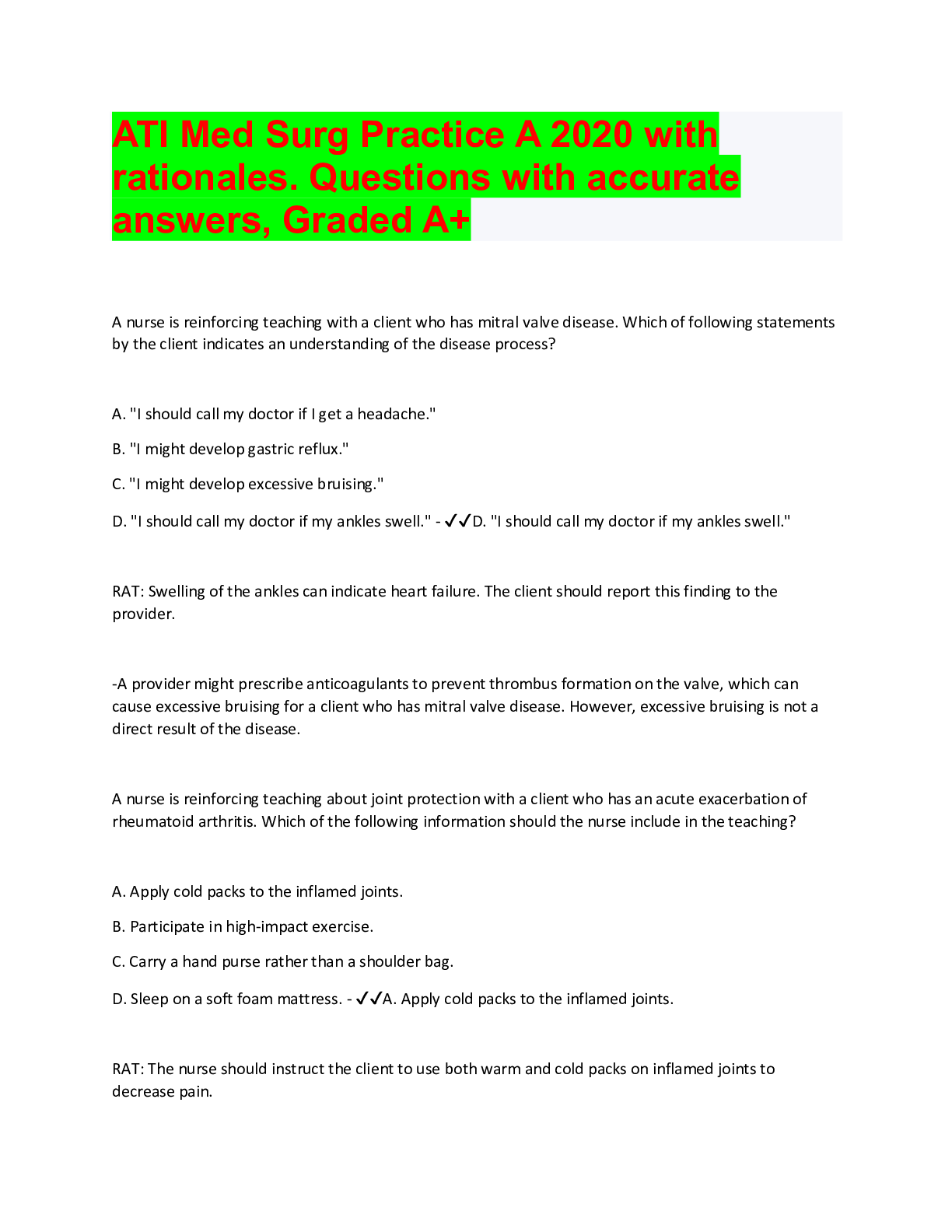
Reviews( 0 )
Document information
Connected school, study & course
About the document
Uploaded On
Aug 26, 2022
Number of pages
48
Written in
Additional information
This document has been written for:
Uploaded
Aug 26, 2022
Downloads
0
Views
132

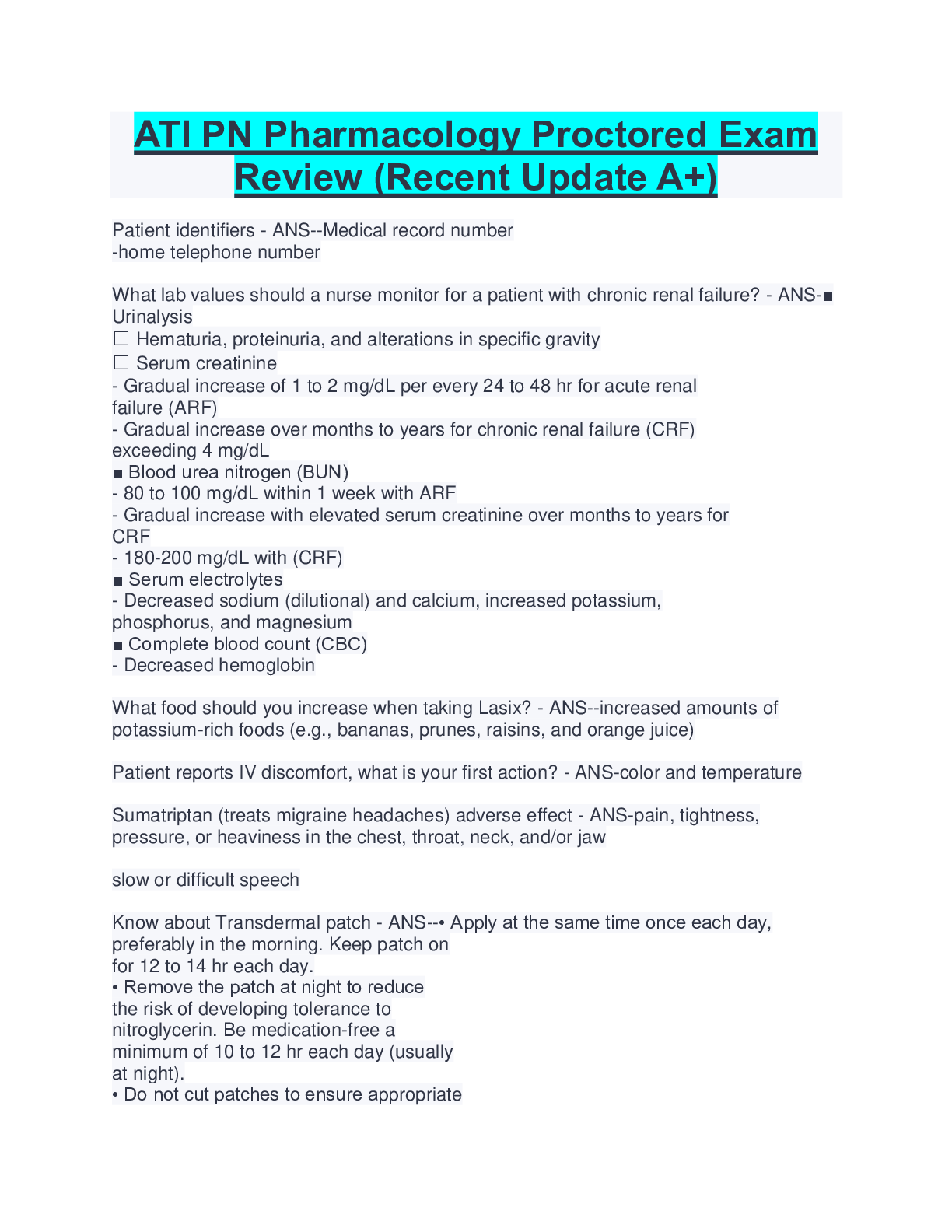



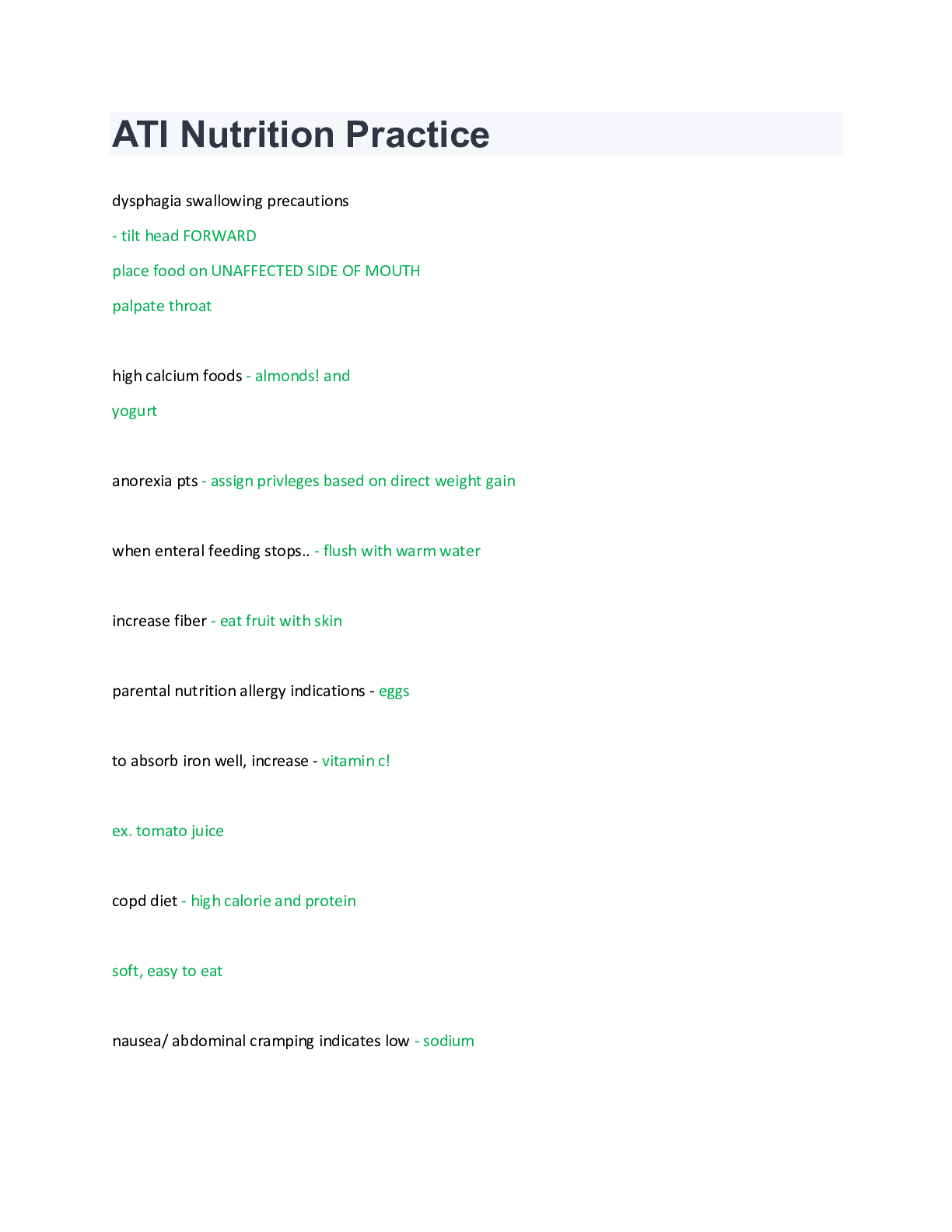
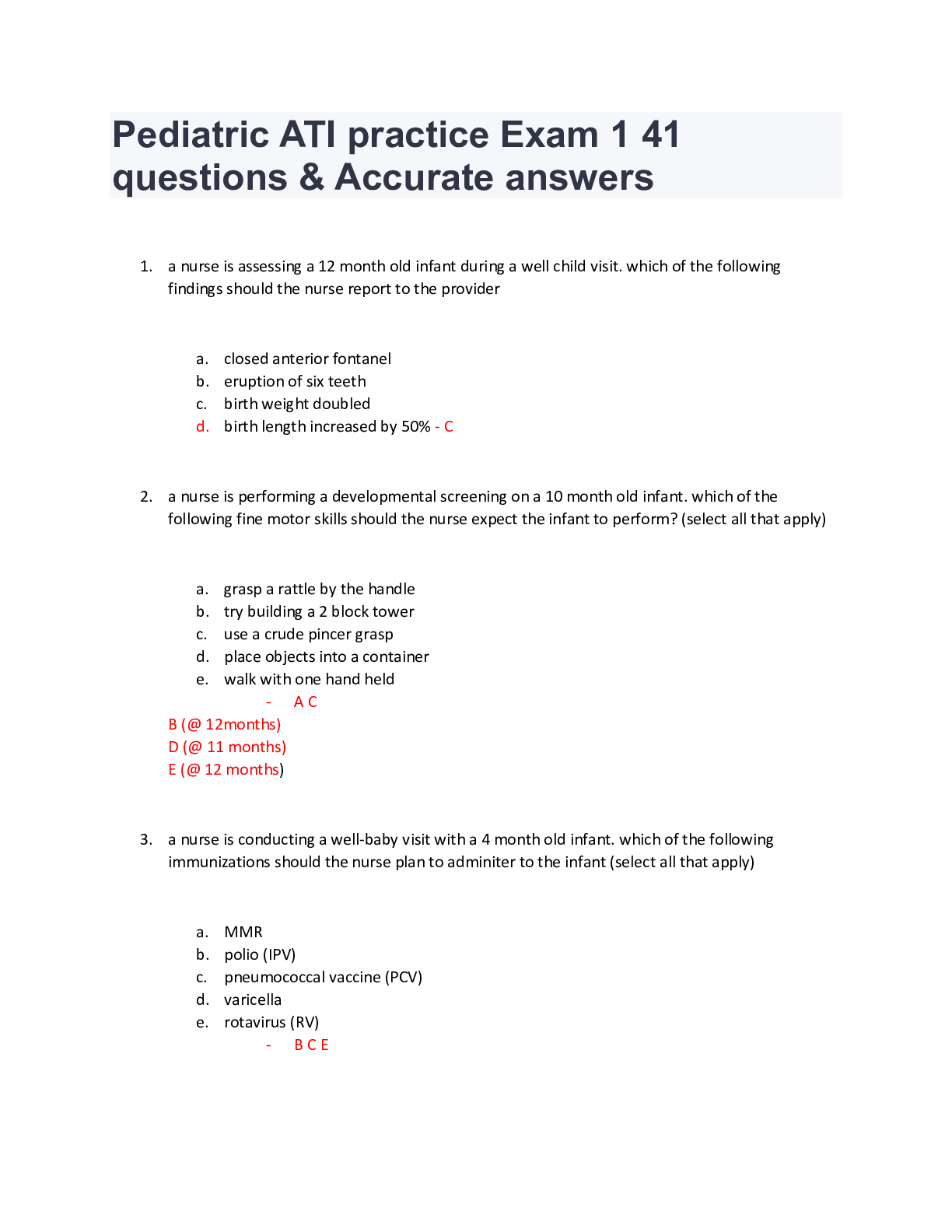
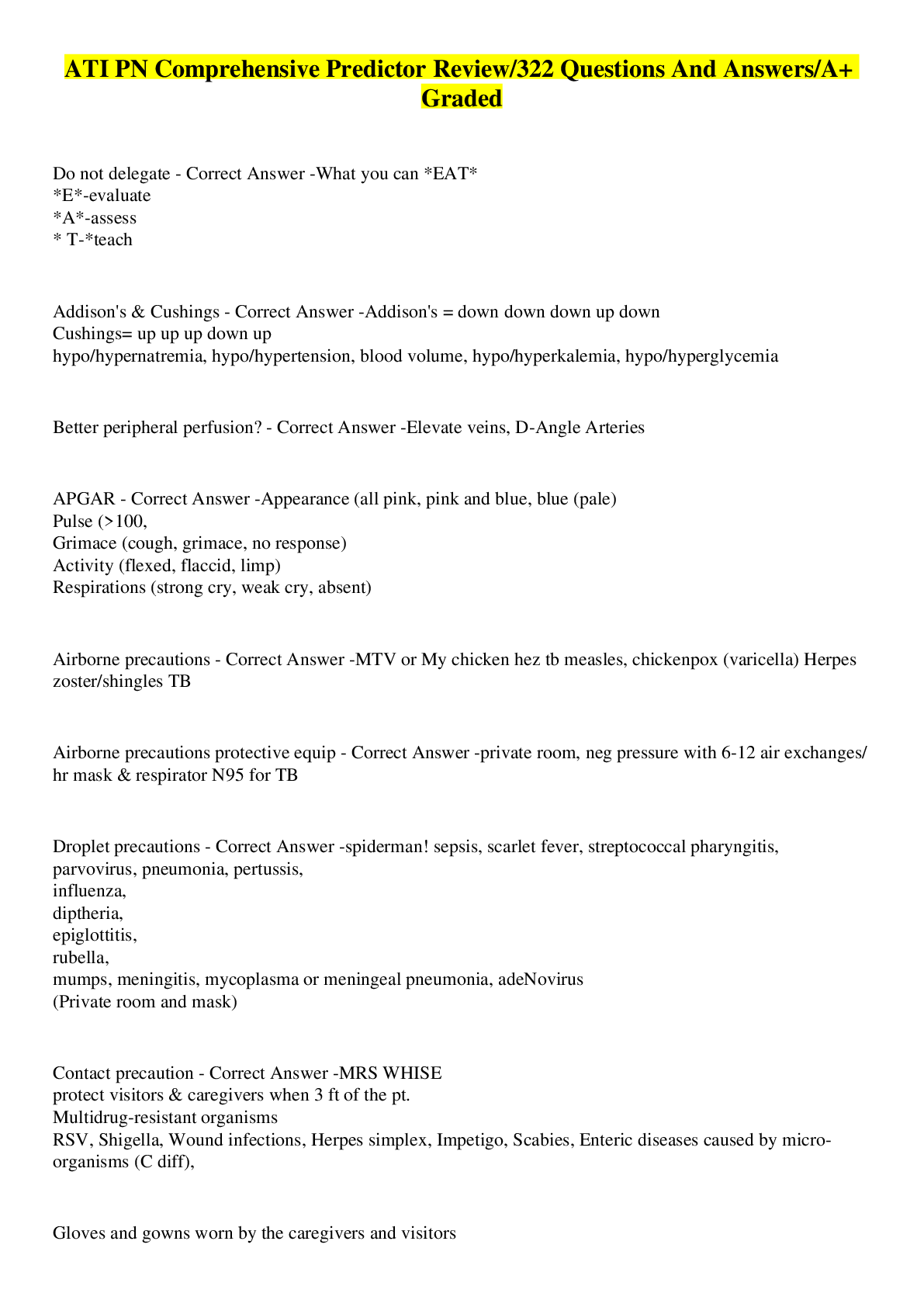
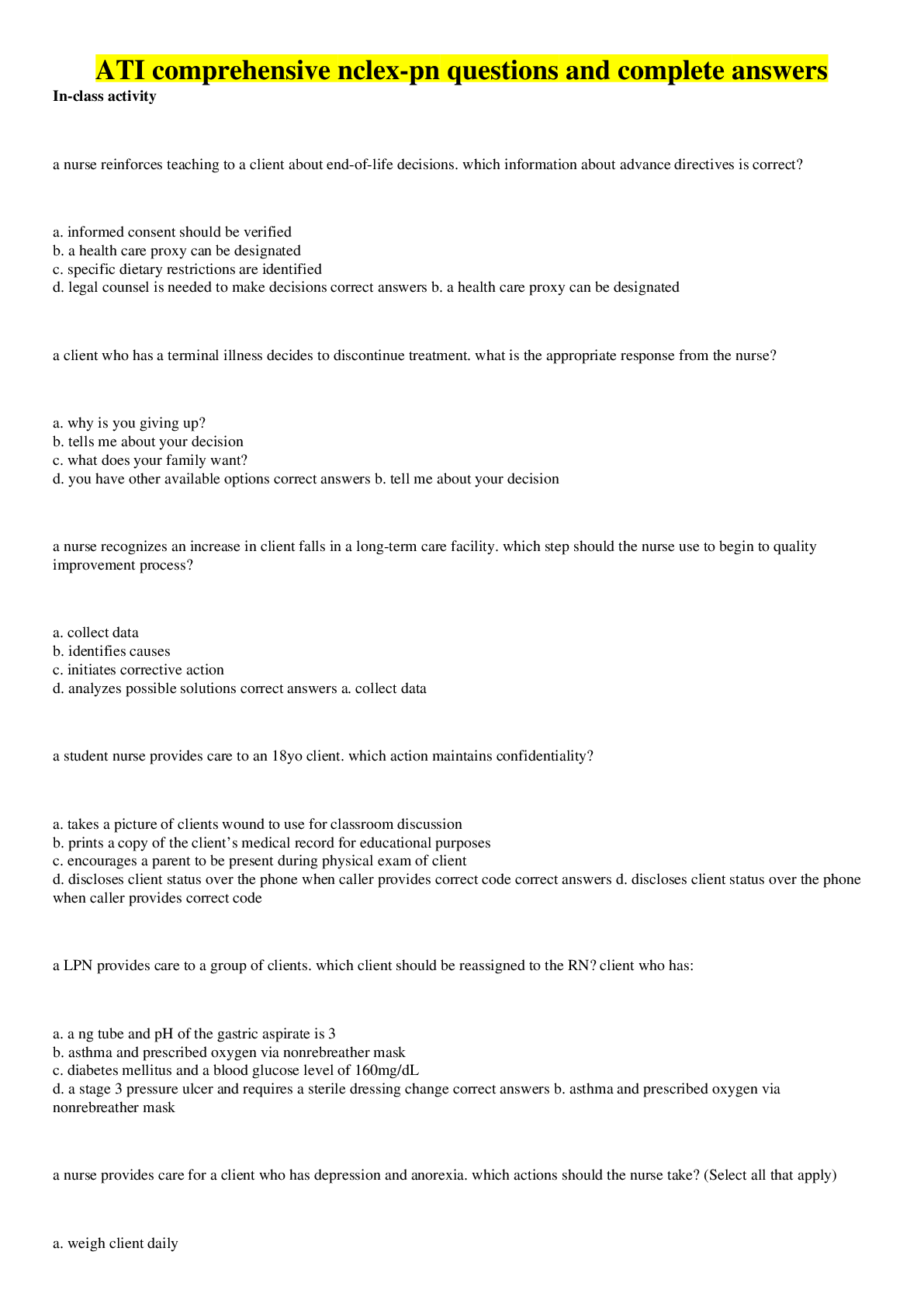
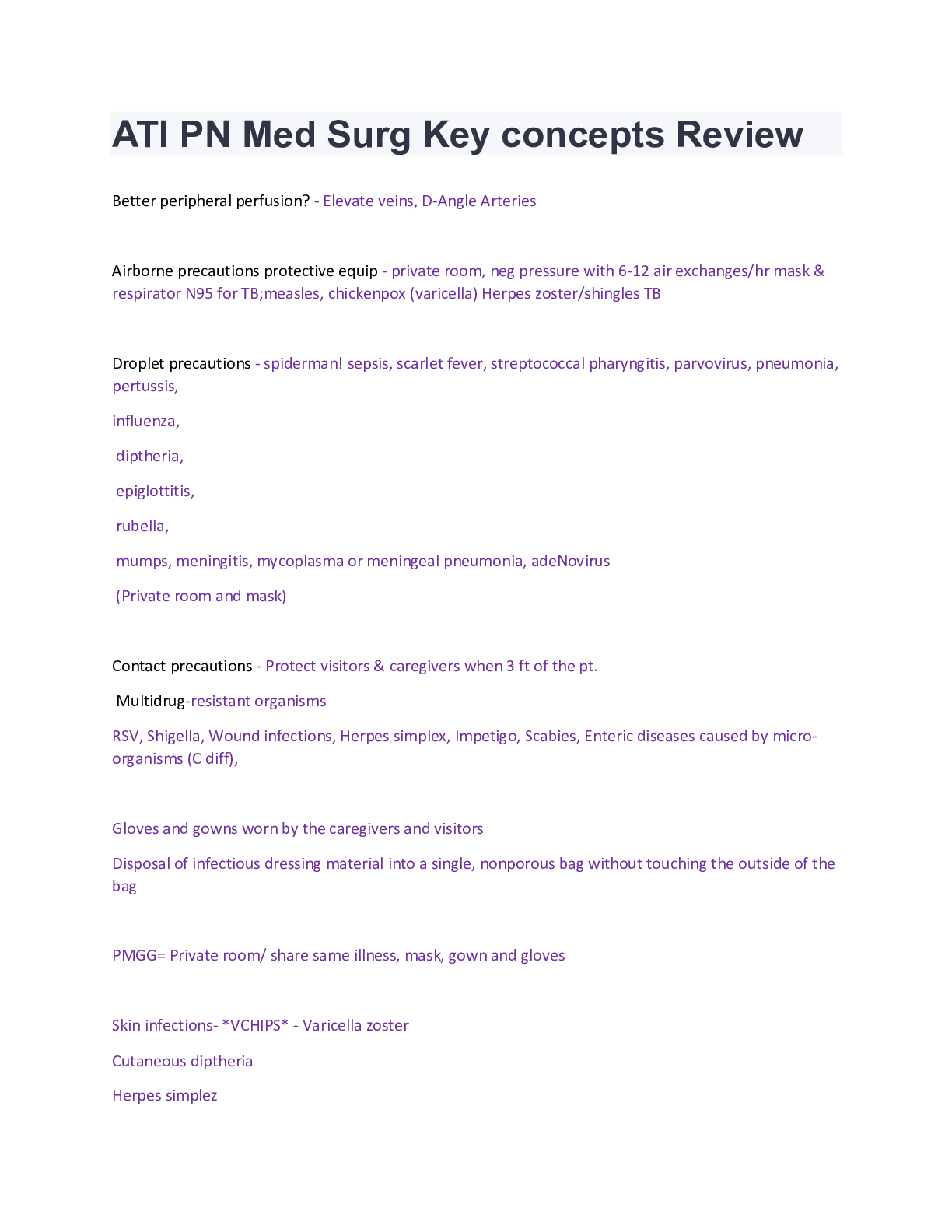
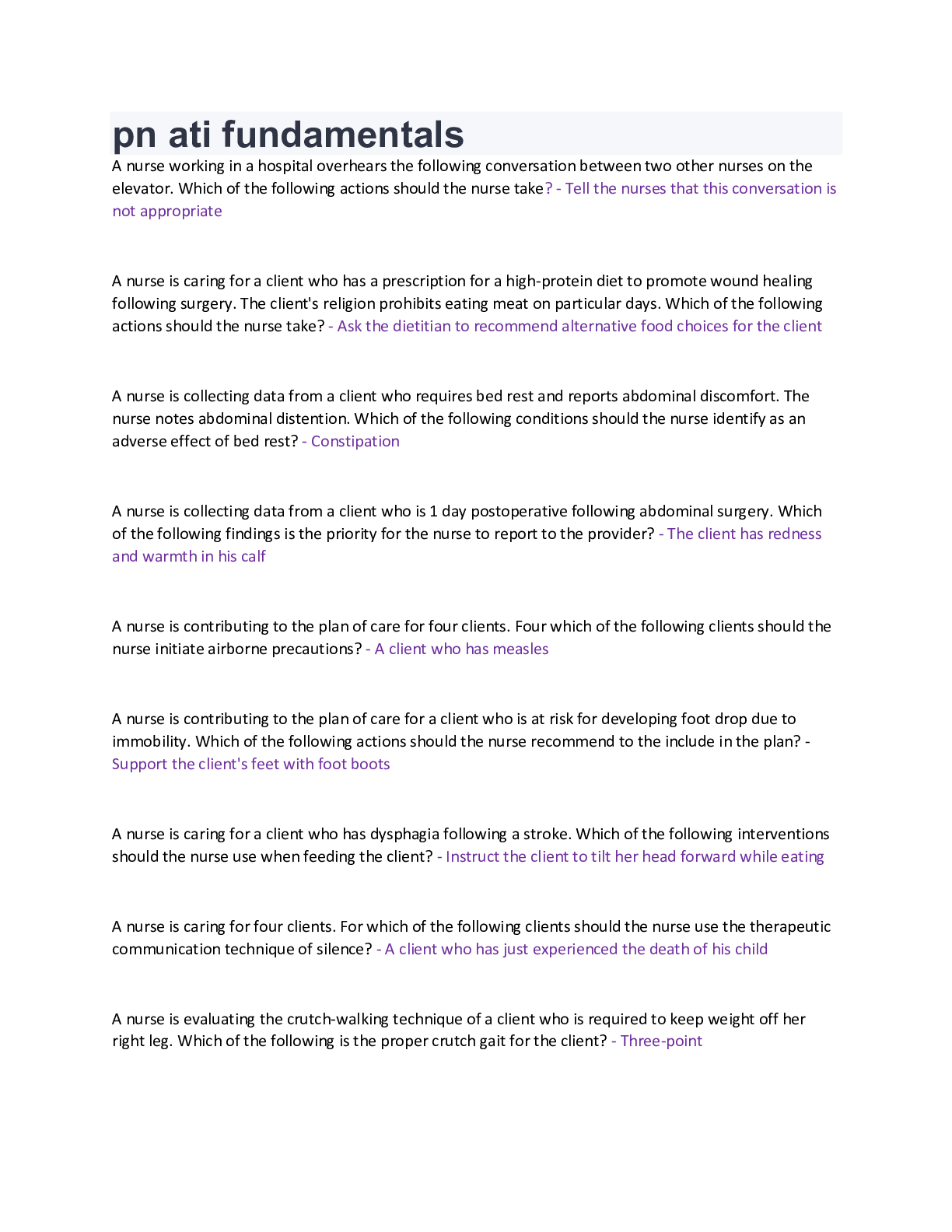

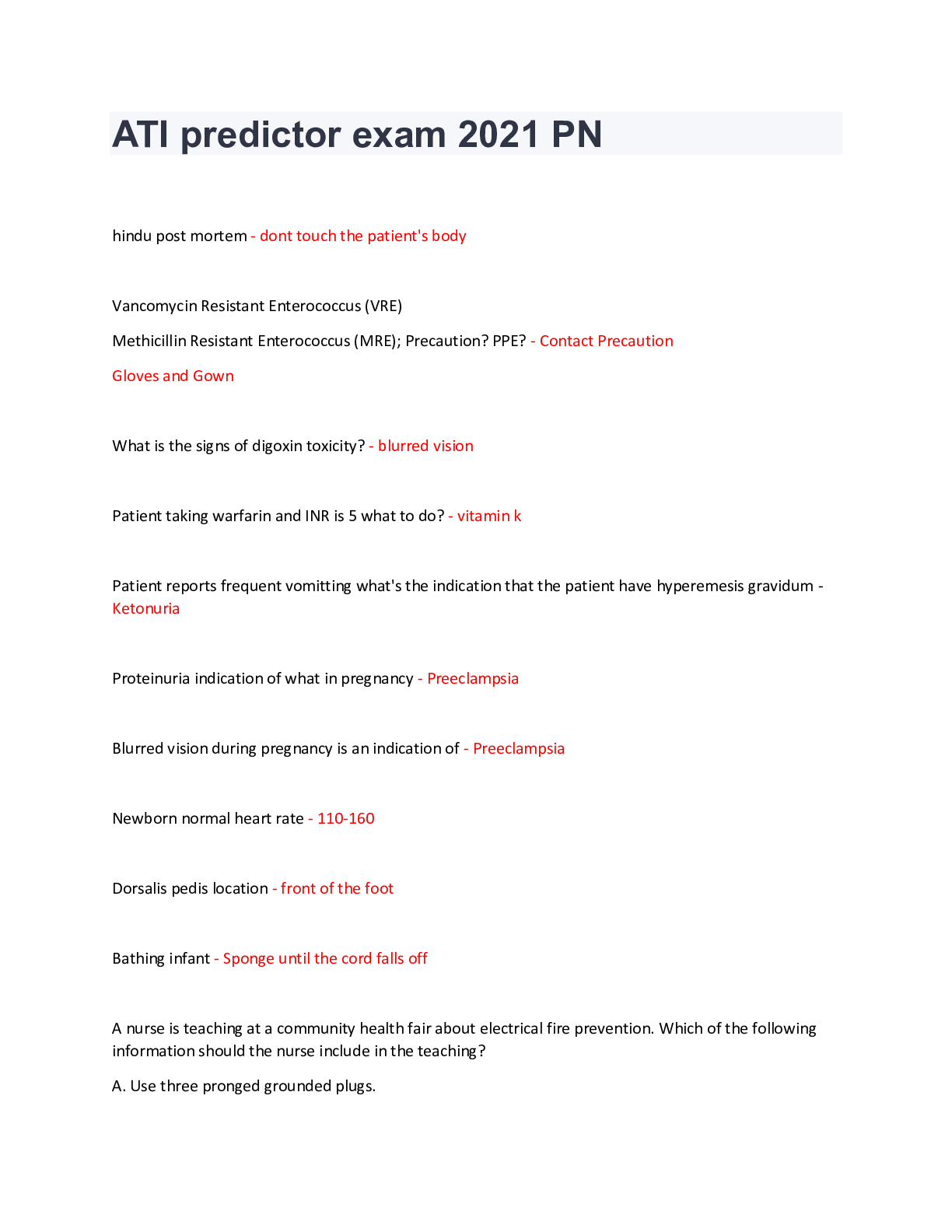
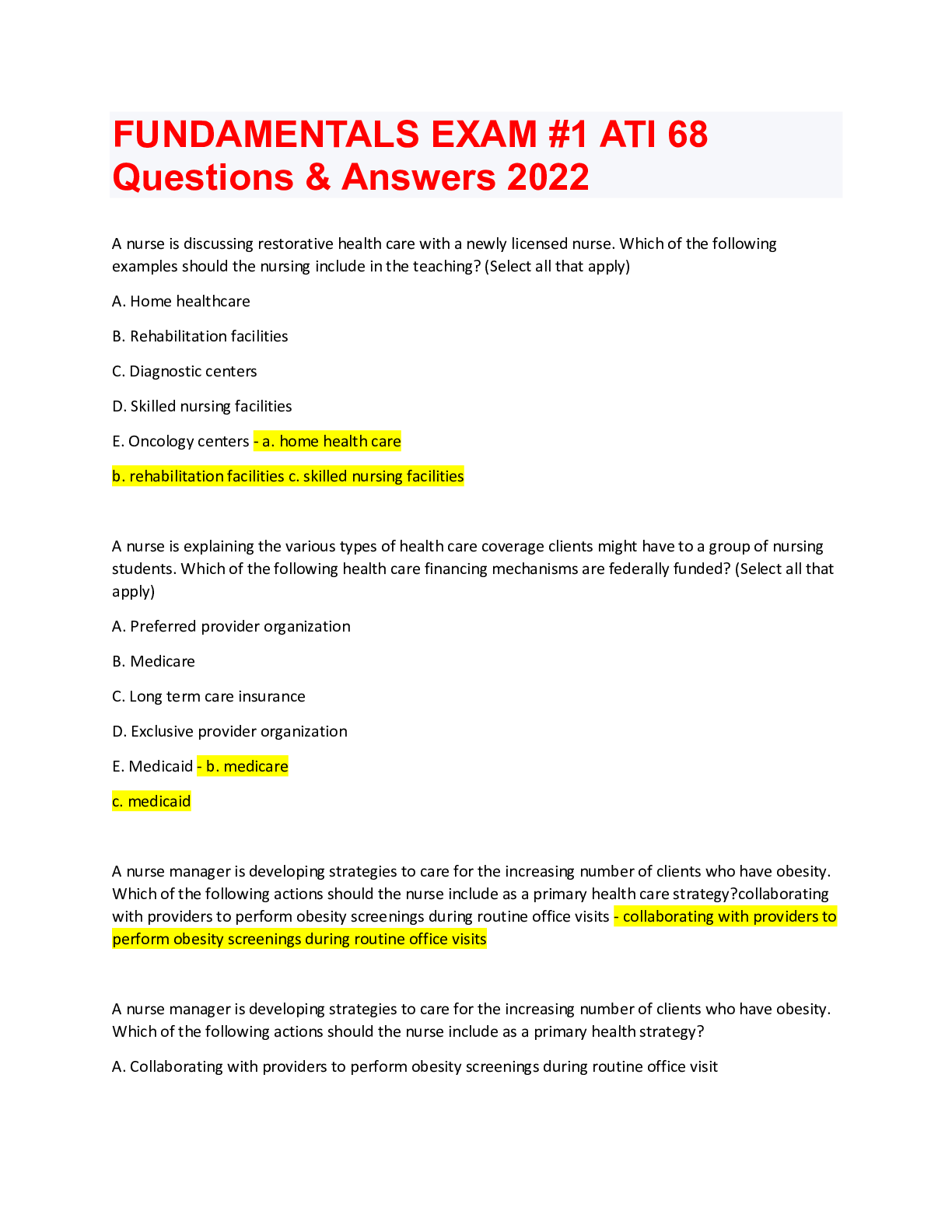
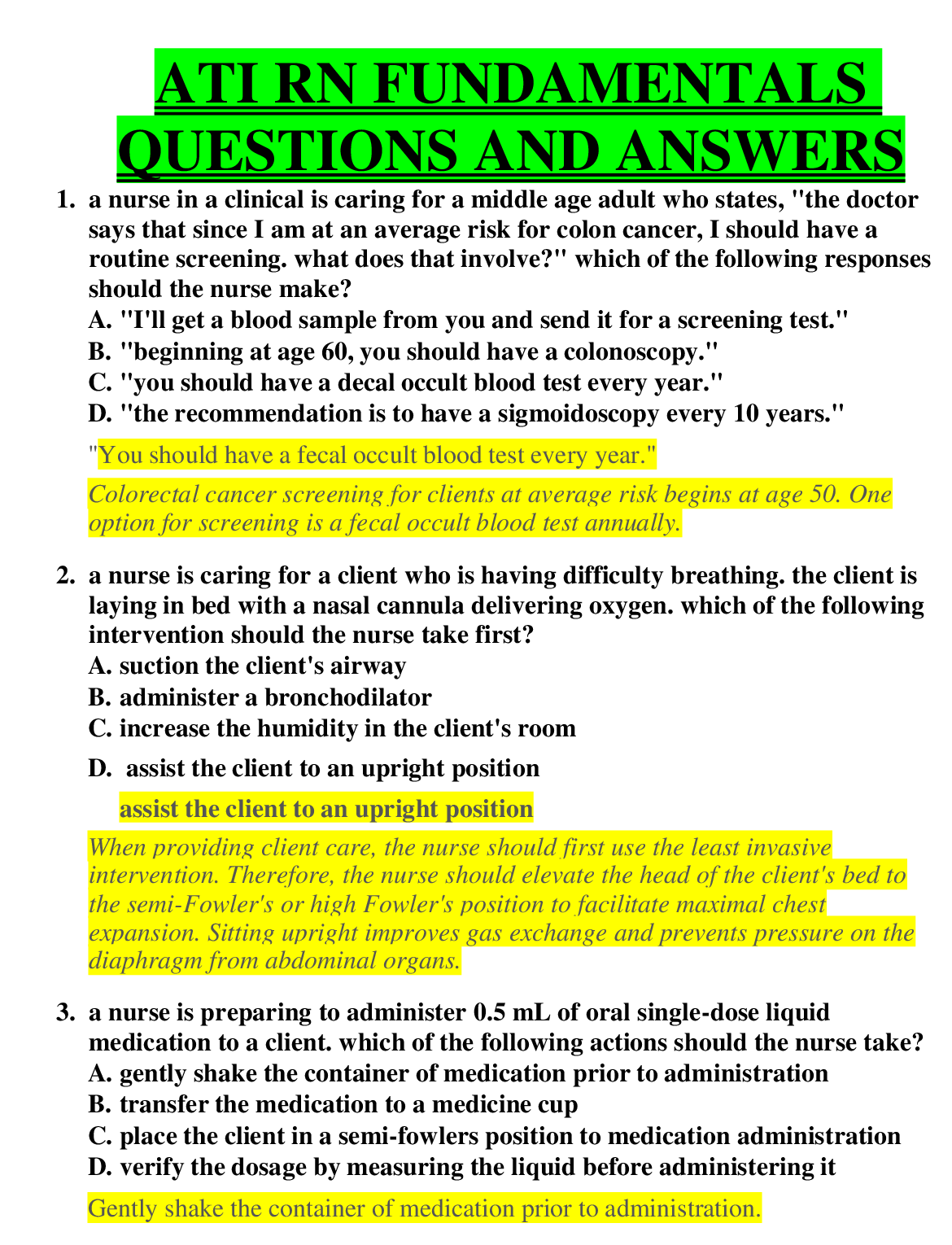
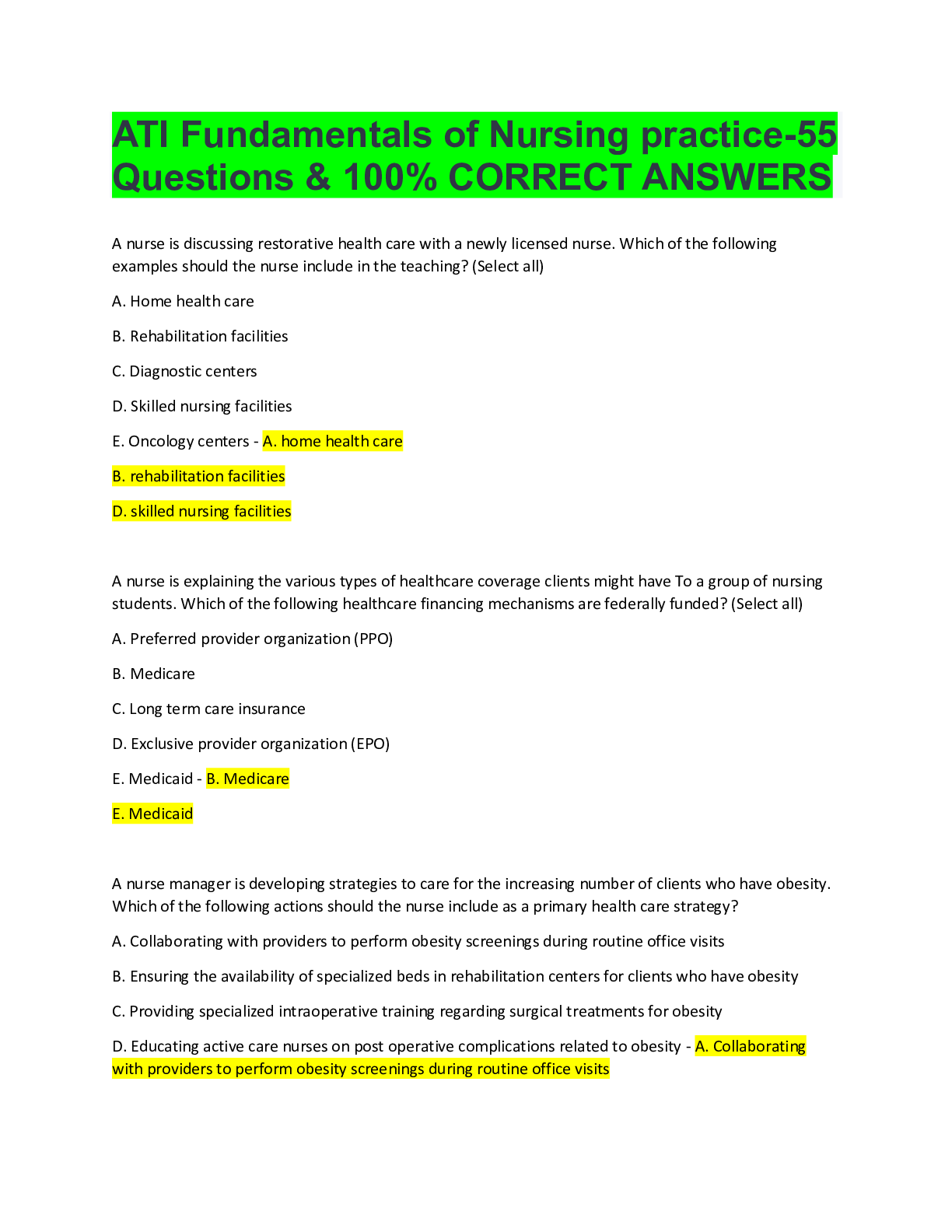
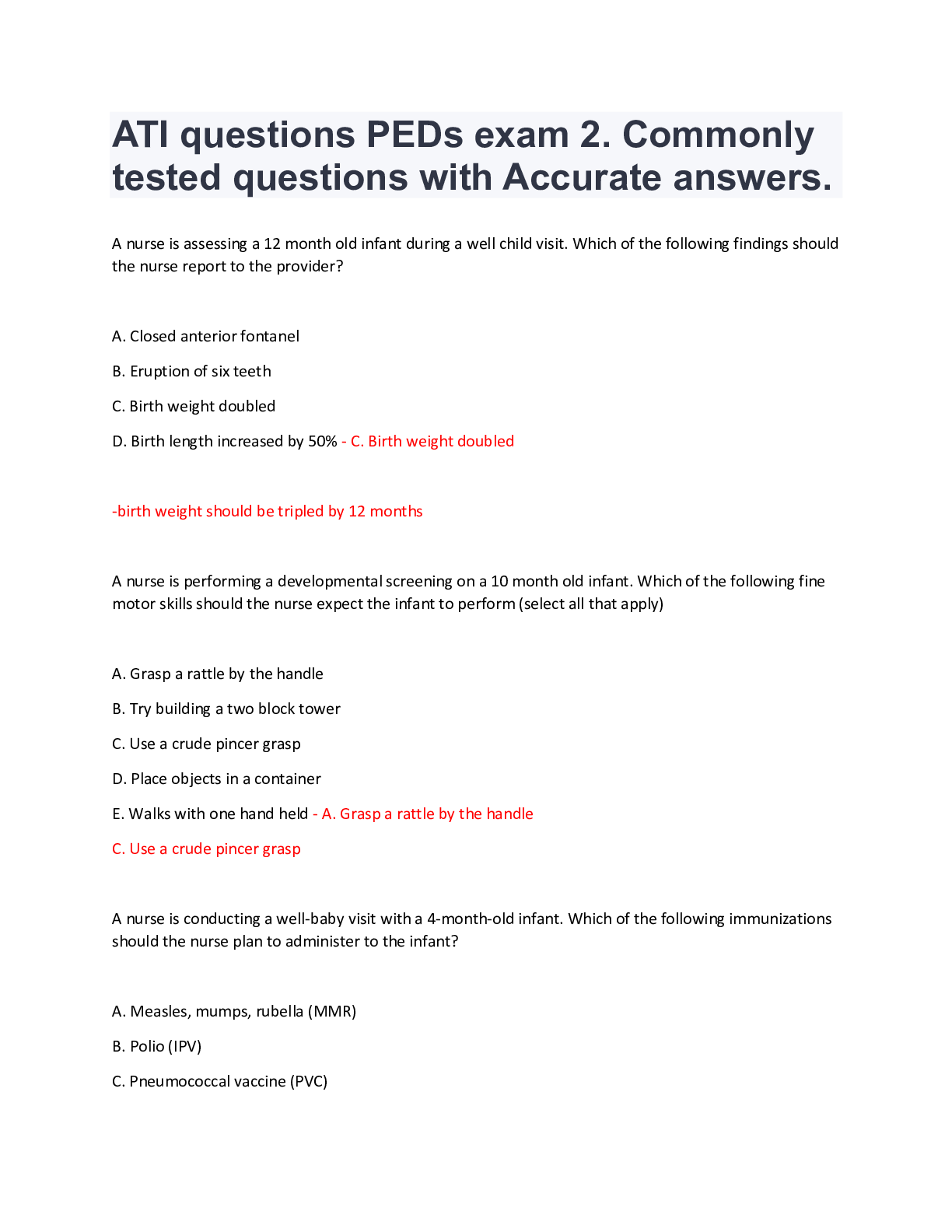
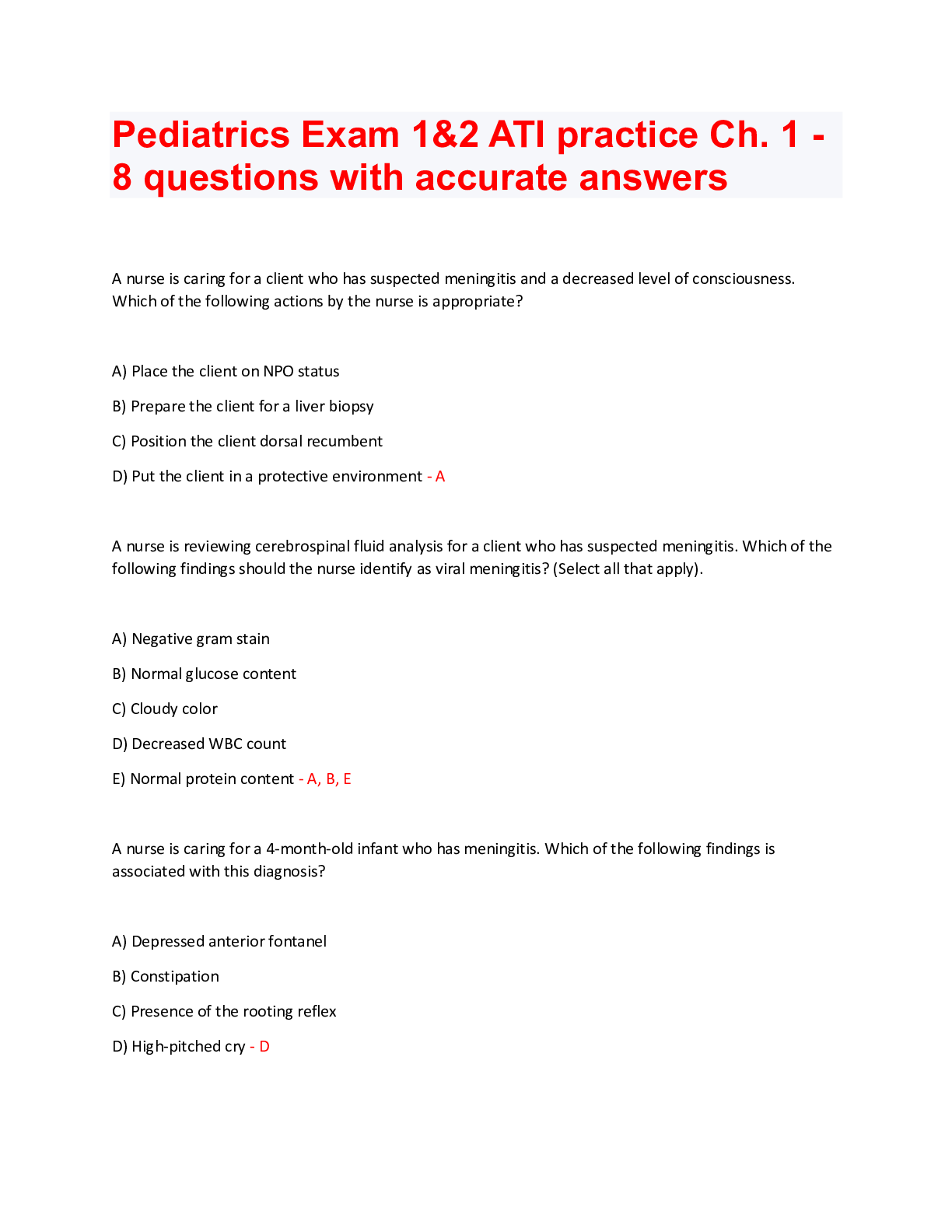
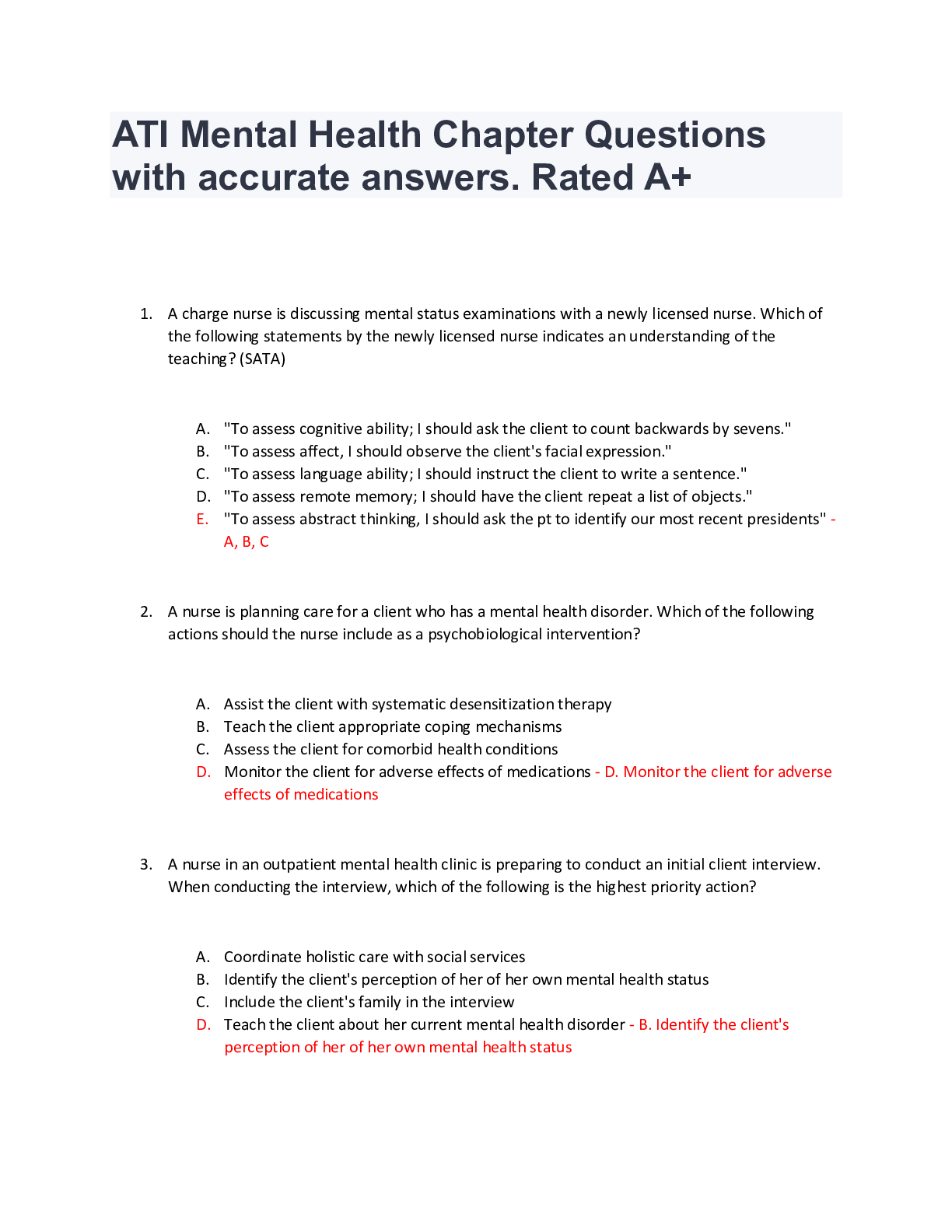
.png)
.png)
.png)
